If ever there were a revolver that could be considered “mythical” it would be the Colt Python. The Python has been the “Grail gun” for some, the warmest of memories for others, or some combination of both for many a revolver enthusiast. I must admit the reputation of the Python makes the new, 2020 Colt Python an intimidating gun to write about, especially for a guy with no experience with the original. But I’ll try anyway.
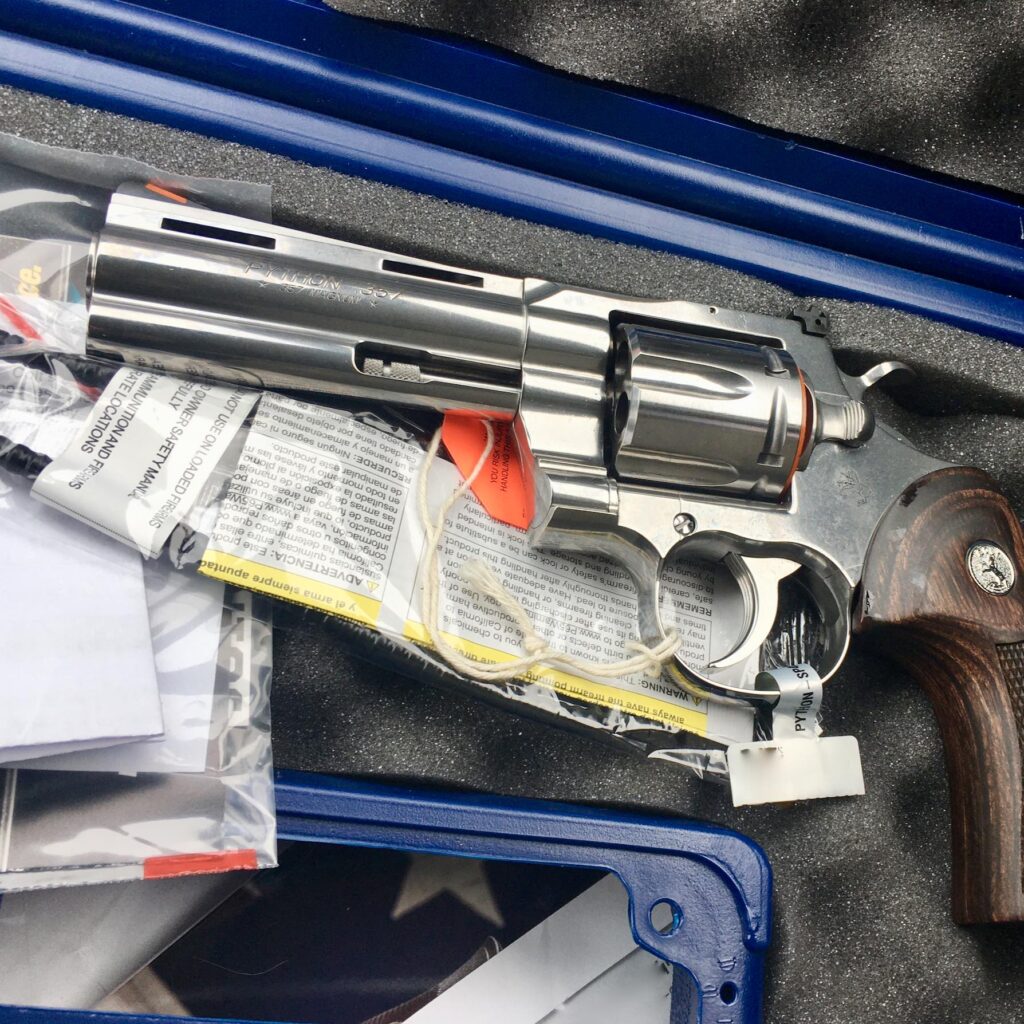
The 2020 Colt Python has big shoes to fill. As I said, I have exactly zero experience with the original Python, so this won’t be a comparison between the two – I just don’t have the requisite knowledge. This will be a review of the new, 2020 Colt Python on its own merits.
2020 Colt Python
The 2020 Colt Python is a six-shot, stainless steel, double-action revolver chambered in .357 Magnum. The barrel comes in two lengths: 4.25 inches and 6 inches, and we were loaned the shorter of the two. Like the King Cobra and the King Cobra Target, the Python bears a recessed muzzle crown below an interchangeable front sight blade.
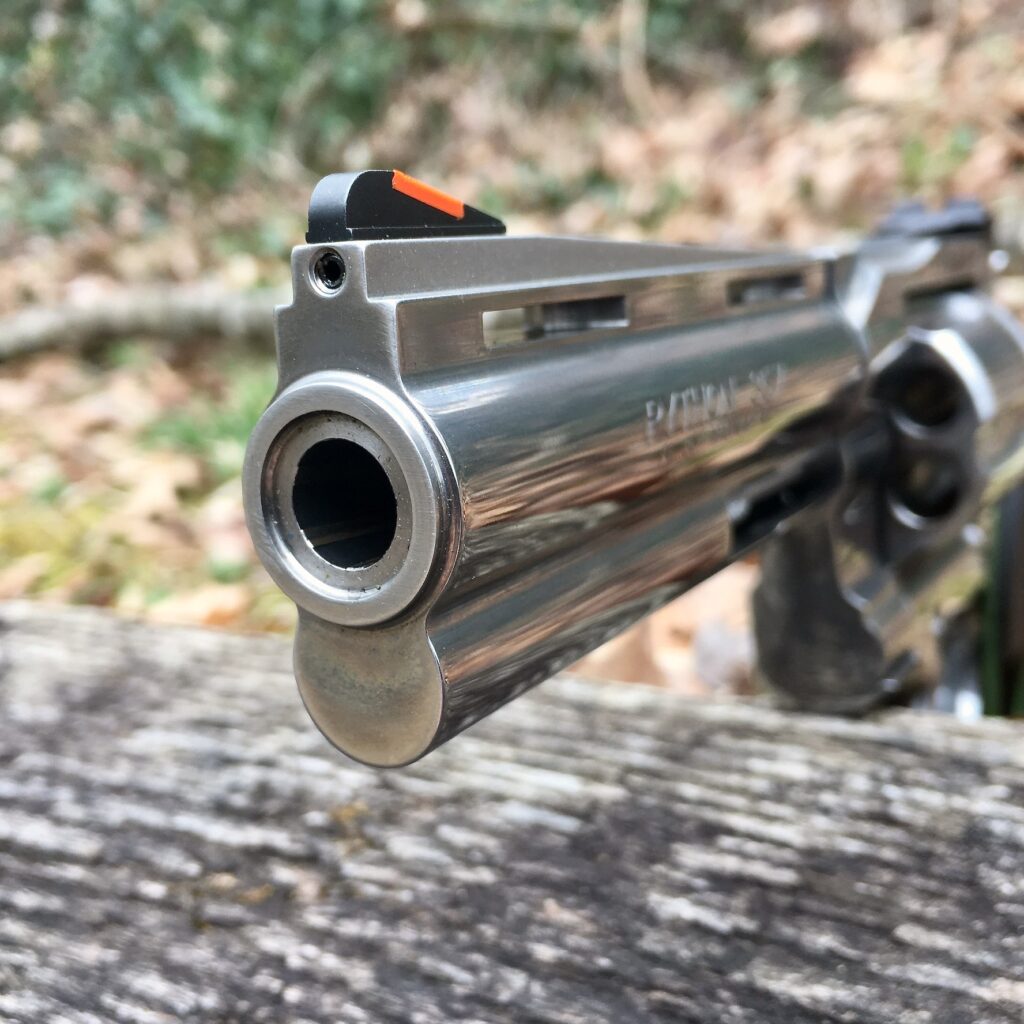
The most visually striking and immediately identifiable feature of the Python is the famous ventilated rib over its heavy barrel. I’m not going to lie – this has never been a look that appealed to me but as with most things aesthetic it took a backseat to function, and soon I found myself appreciating it. The inferior margin of the barrel is bounded by a heavy, full-length underlug.
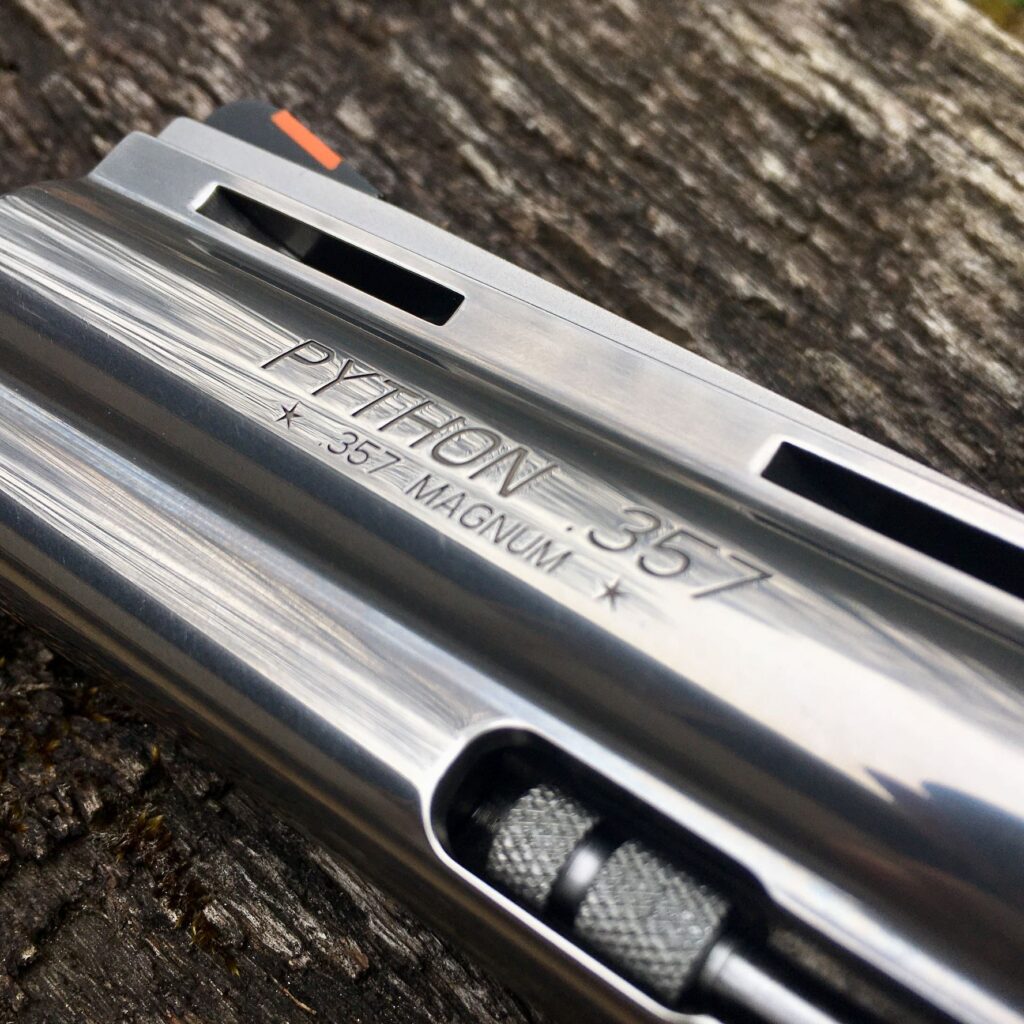
Combined with the rib and and barrel’s existing heavy profile, this adds up to a good bit of weight forward on the gun. This is one of my very few – and very minor – complaints about this revolver: for some reason the it “feels” heavy. The first time picked up my 686 after shooting the Python for a while I though the S&W revolver was light. It felt almost wispy – puny even – compared to the Snake gun. As it happens, the Python is actually about 4 ounces lighter than the Smith but feels heavier, again, possibly due to the greater forward mass.
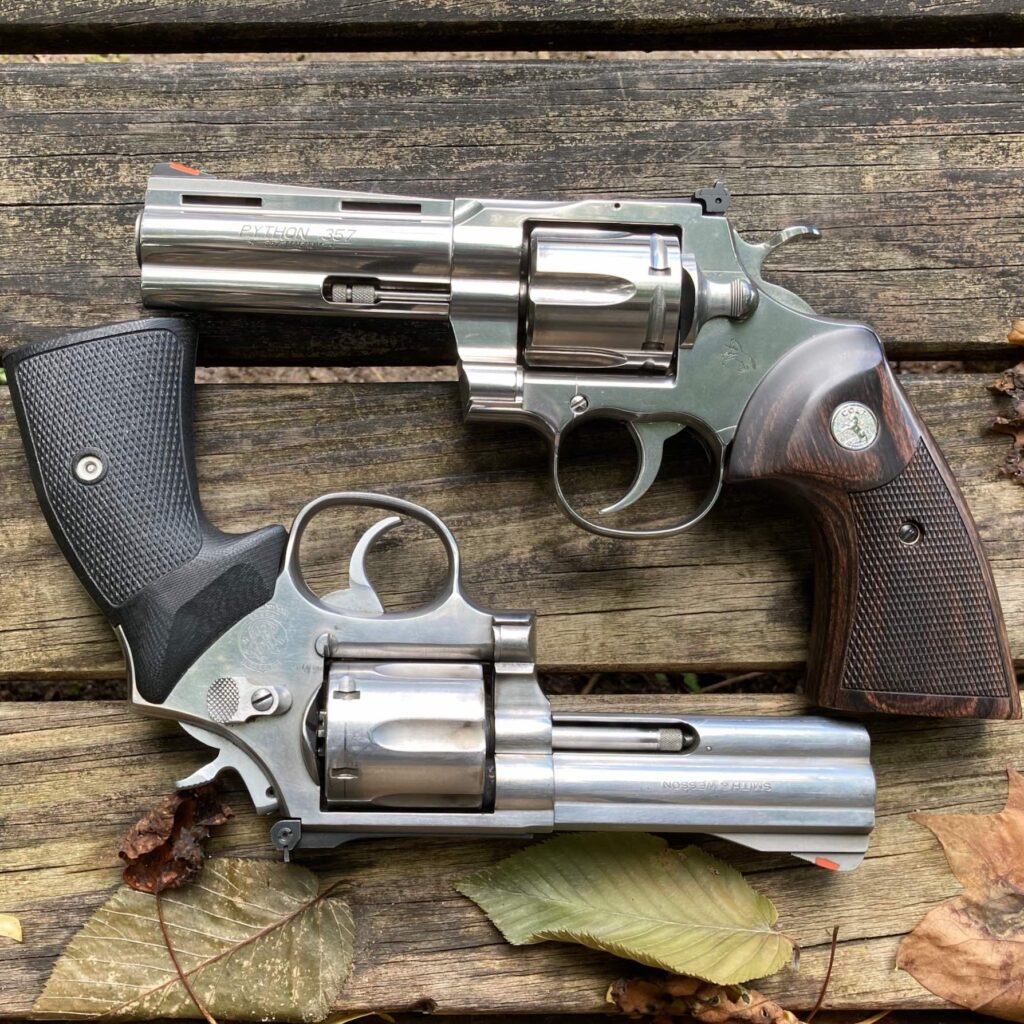
It’s hard to tell where the weight savings in the Python are coming from. The Python’s frame looks extremely thick, both in the forward, crane area (compare with the 686 above) and in the top strap. For a gun that is sometimes criticized as delicate, it certainly doesn’t look it from external appearances. Unlike newer offerings from Colt’s, the Python’s trigger and trigger guard are unmarred by progress and of the classic, familiar shape.
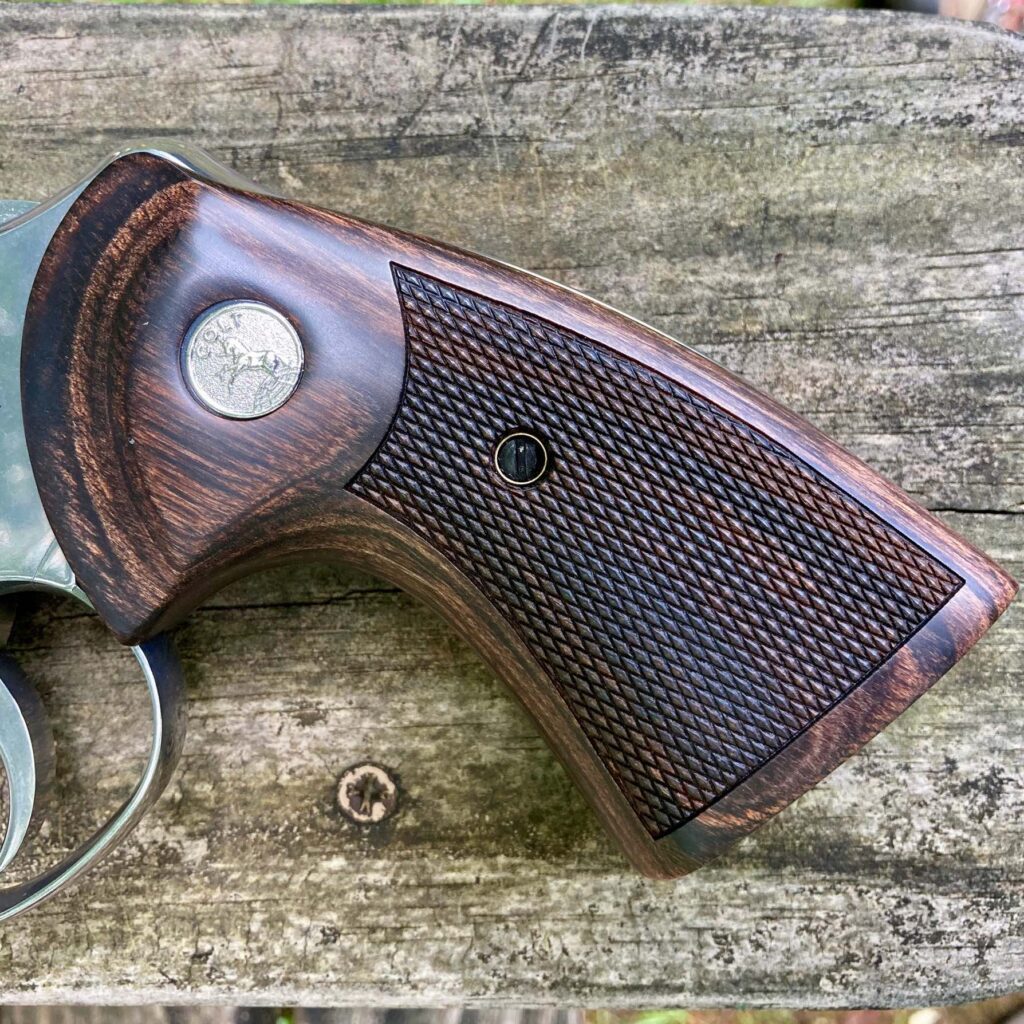
Likewise the grips. The wooden grips are an open backstrap design with Colt’s Rampant Pony medallions and checkering. While I didn’t find aesthetics of the grips objectionable in the least, I also didn’t find them ideally suited to shooting. More on that in a moment.
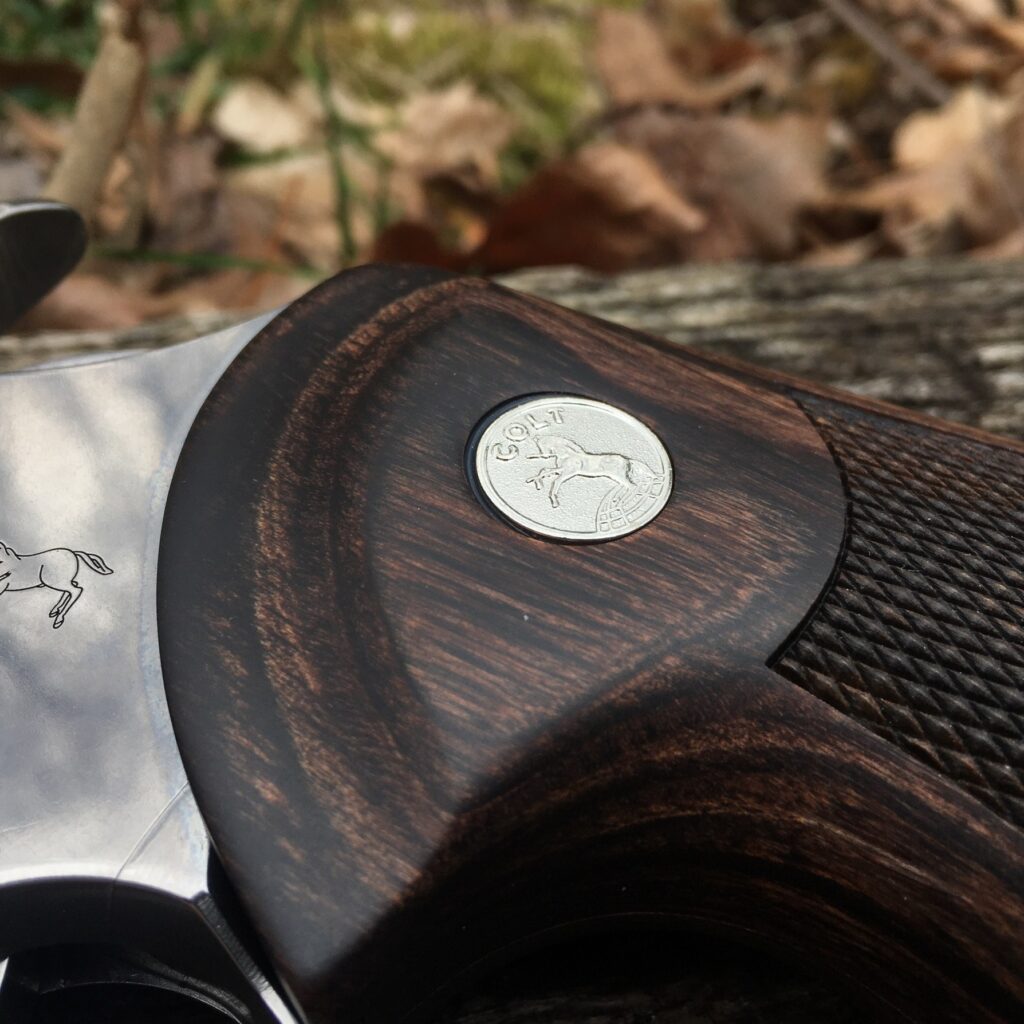
Fit and Finish
And here is what most of you probably want to know about, and the question I can’t possibly begin to answer: how does the finish live up to Pythons of days past? I have no idea, but I can certainly speak to this one. I’m going to be honest, when Mike and I initially got word of a new Python through an invite to Gunsite (unfortunately I got sick and couldn’t make it, and Mike had a previous obligation) I immediately pictured a blued model.
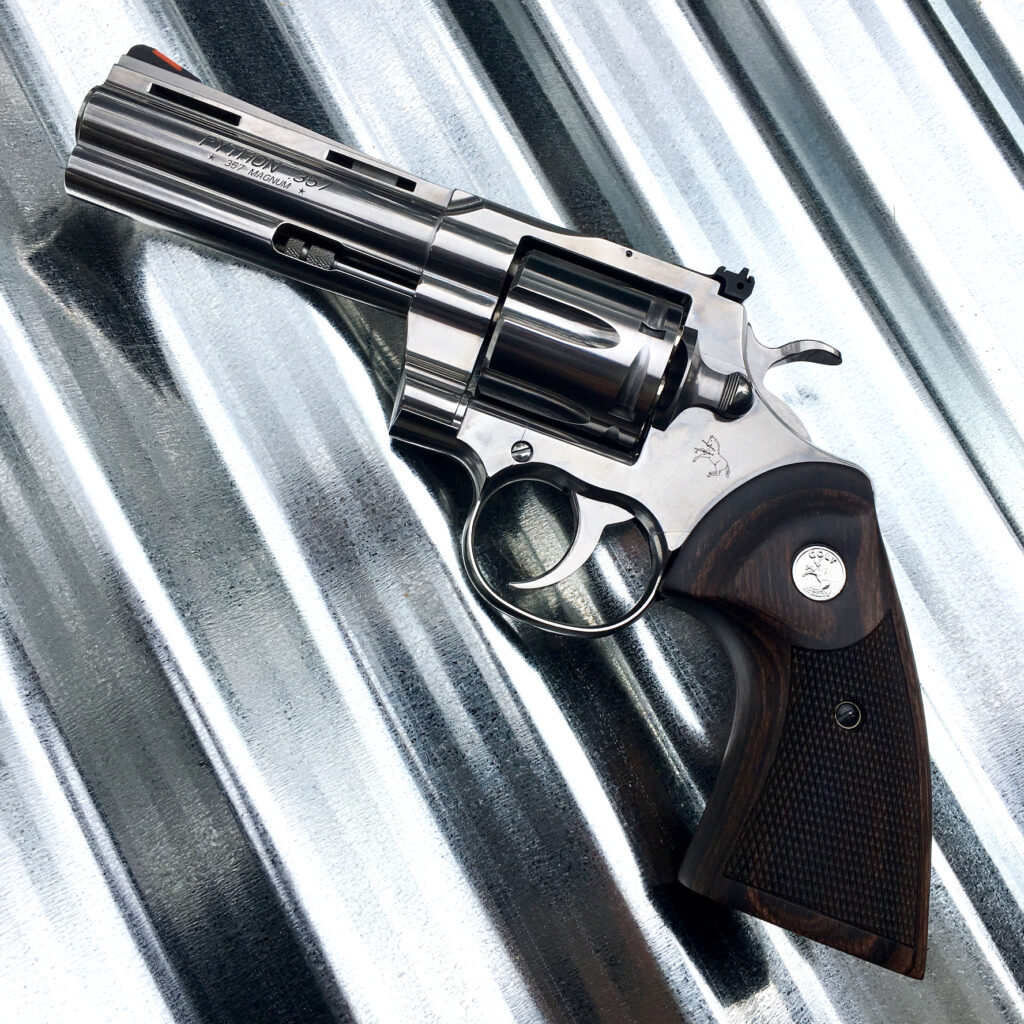
When the new Python was introduced in stainless I wasn’t terribly surprised, but when I picked this gun up I was surprised at the quality of the finish. It is outstanding. It is polished to a mirrored finish that is incredibly smooth. To be honest, I found it challenging to take photos of this revolver without including my own reflection. The finish – something I normally don’t care about all that much – is truly impressive.
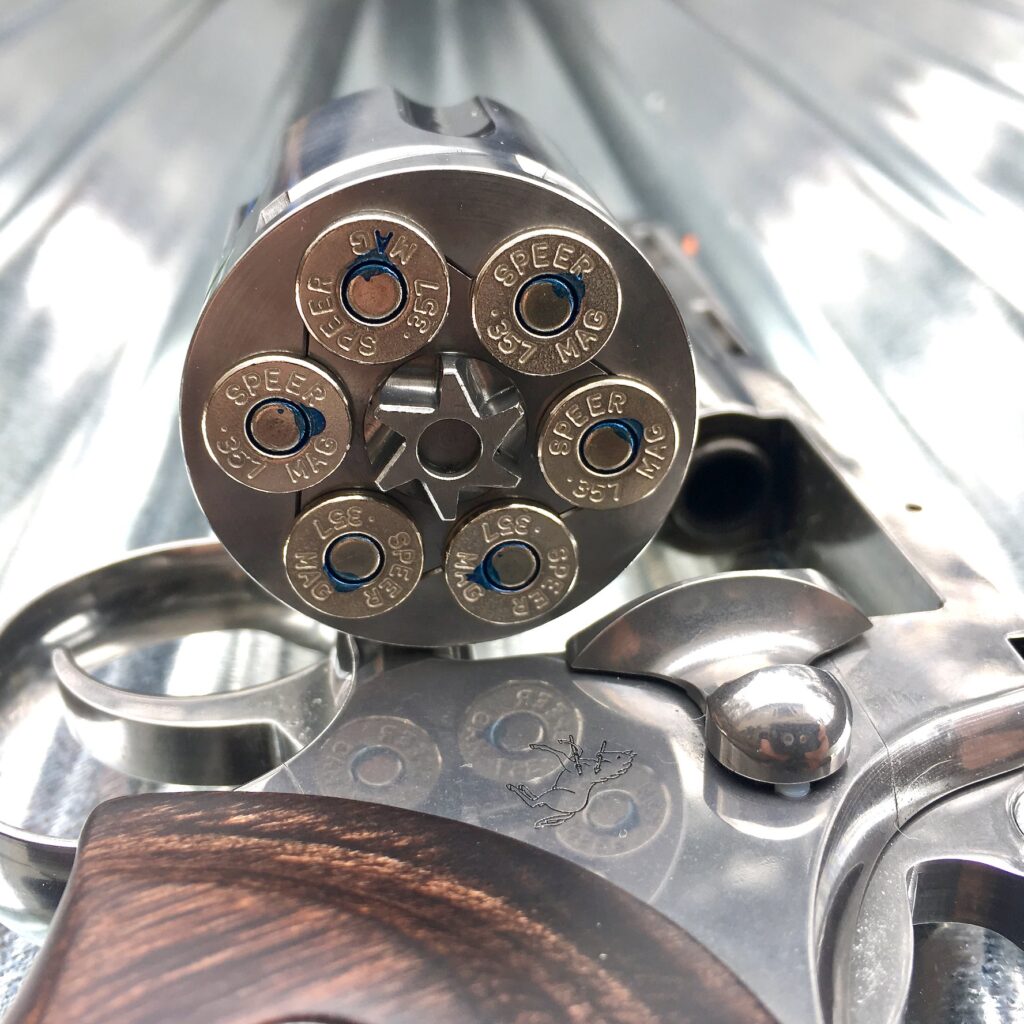
And likewise with the fitment. There is no undesired movement anywhere; lockup is extremely tight. It’s hard to say which Colt is better – this or the King Cobra series – when it comes to smoothness of action. It’s hard to overstate. Swinging the cylinder open would lead one to believe it was rolling on ball bearings. With my King Cobra there was an annoying misalignment of the sideplate, but not so with the Python – everything mates up perfectly. As fit and finish goes Colt has done an amazing job with the new Python.
Trigger
Since the trigger is one of the most oft-cited pinings for the legendary Python, let’s talk about the trigger a bit. Raw numbers up front: I recorded seven double-action trigger pulls. They came in at 10 lbs, 1 ounce, 9 lbs, 14 ounces, 10 lbs, 0 ounces, 10 lbs, 3 ounces, 9 lbs, 14 ounces, 9 lbs, 15 ounces, and 9 lbs, 15 ounces, for an average of 9.98 pounds. While I understand it may be slightly heavier than some of the very early, new-model Pythons, ten pounds is about where I want a double-action revolver to be. I have absolutely no complaint in this department.

Cocking the hammer on this revolver reveals one of the smoothest actions I have ever been privy to. Hesitant to engage in hyperbole as I am, I don’t quite feel like that goes far enough, but I’m not sure how else to express myself – it is just incredibly smooth. And this is no anomaly. If you read my King Cobra and King Cobra Target reviews you’ll find the same, glowing review of the trigger weight and smoothness. The single action trigger was also smooth, with zero creep. In fact, there is zero movement of the trigger at all until to breaks.

The Python has a narrower-than-normal window between it’s single- and double-action trigger weights. Again, this is a trend I have observed in the other two Colt revolvers I have reviewed. This resulted in single action pulls came in quite a bit heavier than expected: 5 lbs 11 ounces, 5 lbs 12 ounces, 5 lbs 12 ounces, 6 lbs, 5 lbs 13 ounces, 5 lbs 13 ounces for an average of 5.80 pounds. I do have a bit of complaint here; five point eight points is quite a lot in a single-action revolver trigger. I would find myself wondering if the trigger was ever going to go.
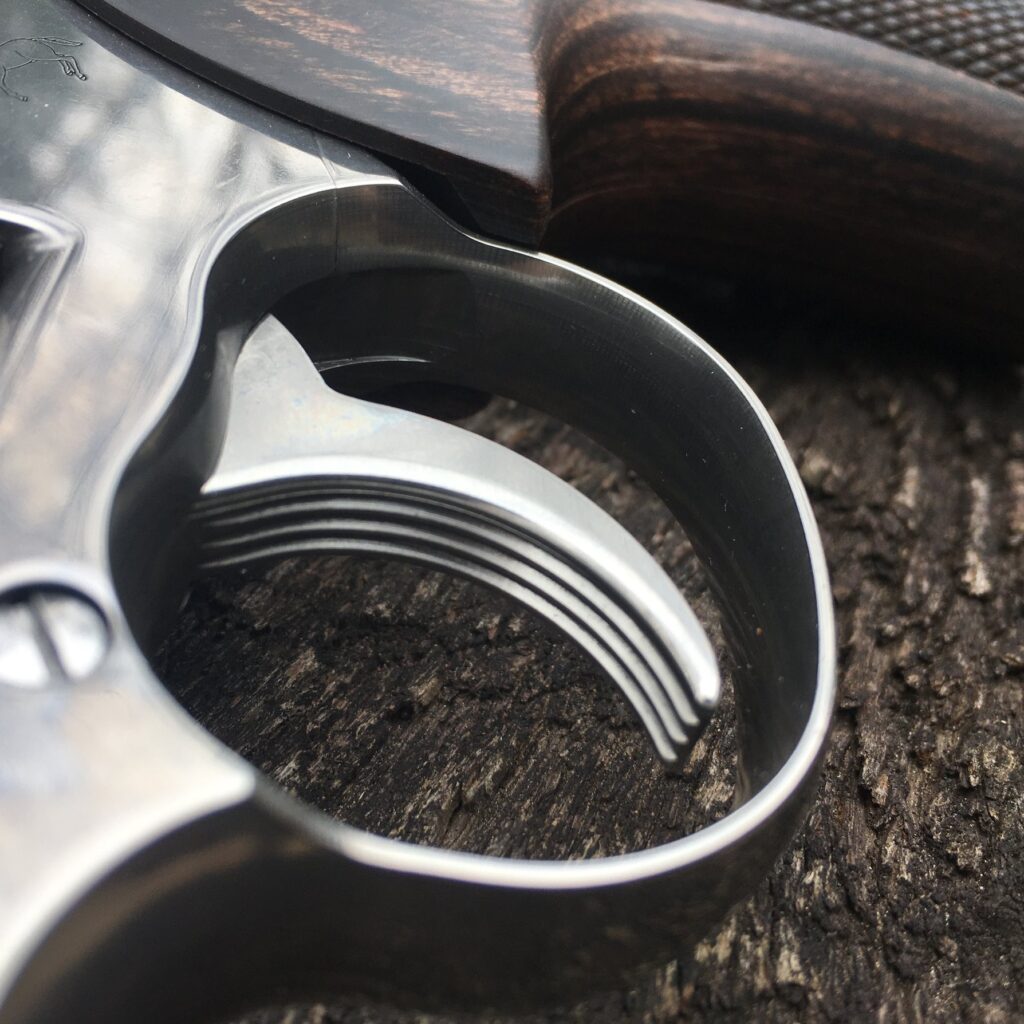
And finally, let’s talk about he trigger itself. Colt’s elected to equip the 2020 Python with a narrow, serrated “service-” style trigger. I don’t believe I have fired very many rounds through revolvers with serrated triggers, and I now completely understand the desire for a smooth “combat” trigger. Overall I could live with this trigger (which is, for the record, comfortably wider than the King Cobra’s) but if I had my ‘druthers I’d prefer a wider, smoother, rounded “combat” trigger.
Sights
The sights on the Python are an adjustable rear sight mated to a fixed (but interchangeable) front sight. The front sight is a black ramp with a serrated, red, plastic insert. I have no problem at all with this style and actually appreciate that it’s black rather than stainless, as is the case with my 686. The front sight may be removed, like all of Colts’ new crop of revolvers, by removing a set screw that appears just over the muzzle.
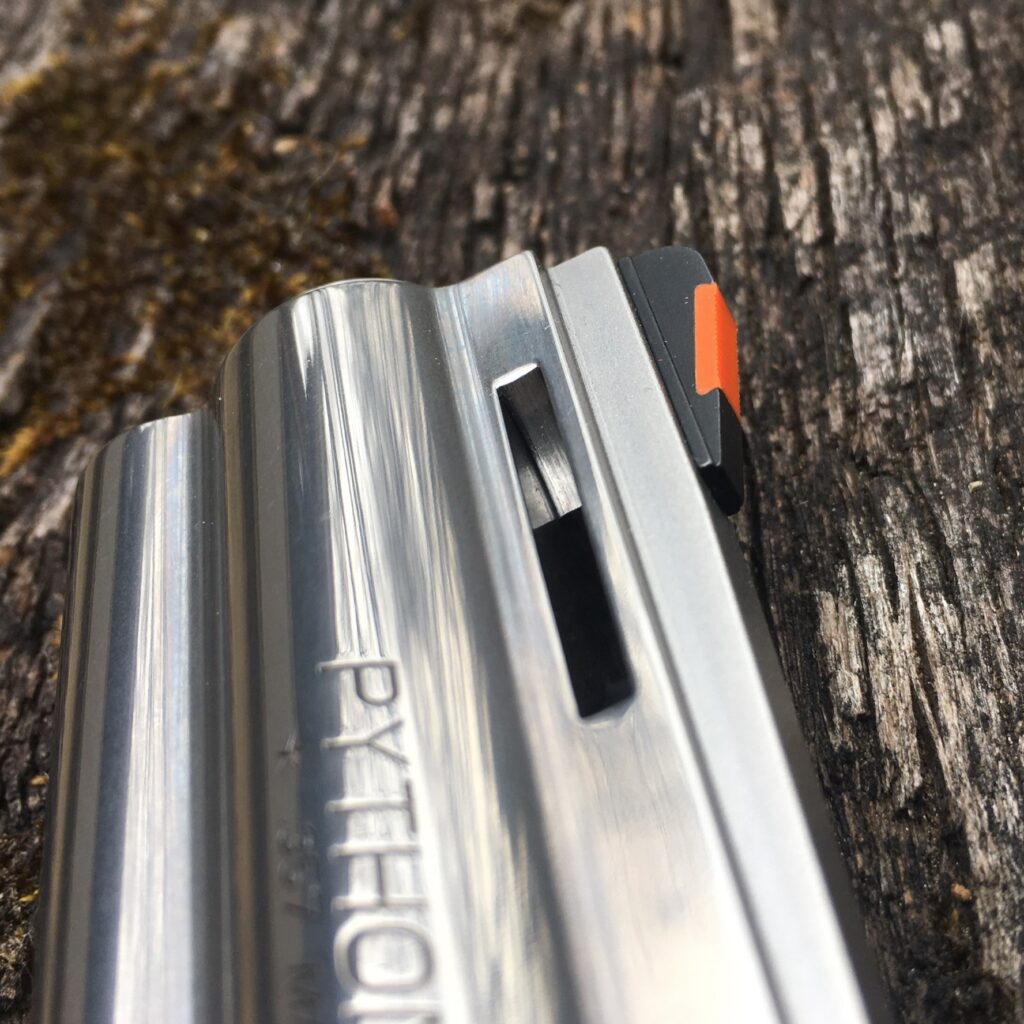
The rear sight is a very traditional windage- and elevation-adjustable unit. Adjustments are made via adjustment screws, and once sights are properly regulated set screws are necessary to preserve regulation. These set screws are not optional, at least on the windage; I found that if I shot before tightening the set screws the rear sight blade would quickly, and significantly drift.
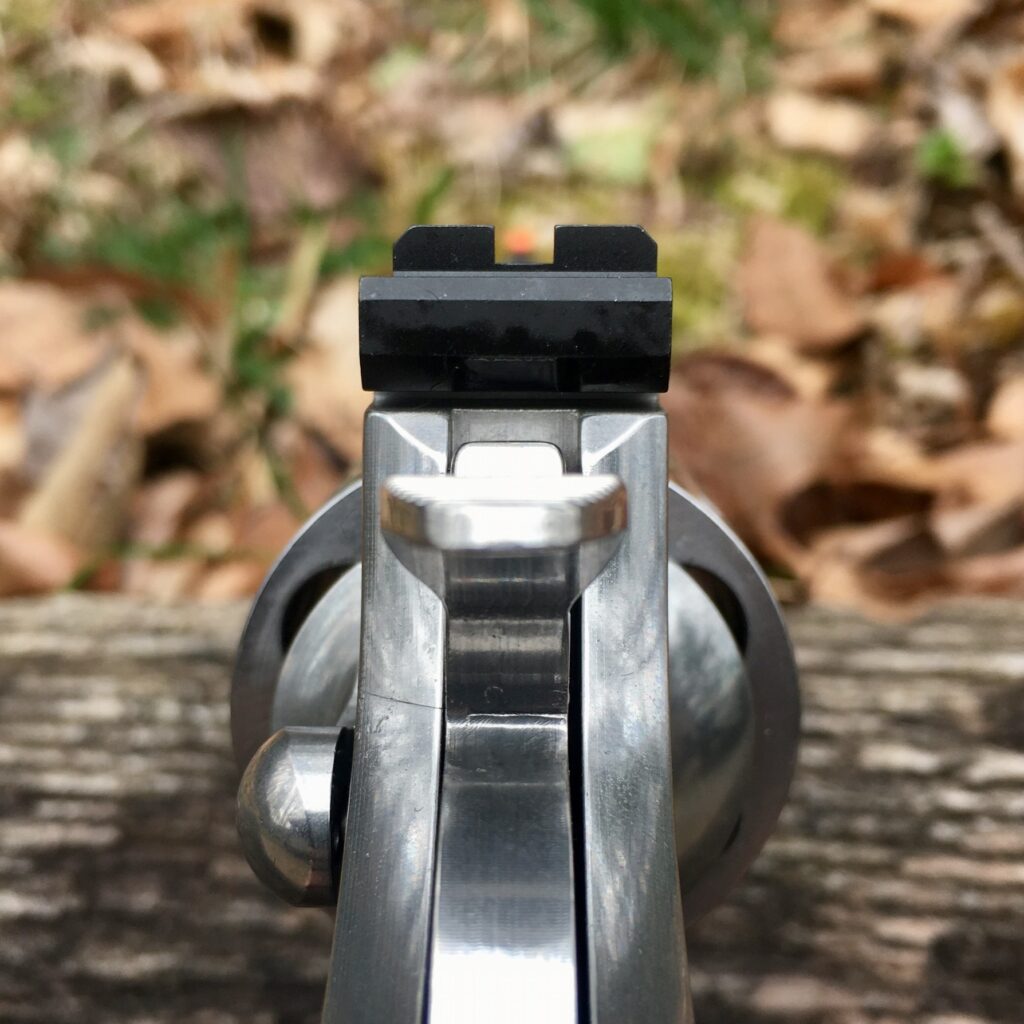
Sights were crisp, clean and as you’ll see shortly, permitted excellent accuracy. I don’t believe I would change a thing about the sights.
Elephant in the Room: Reliability
All told I fired 508 rounds. They came from 9 manufacturers: Federal, Fiocchi, Geco, Hornady, Perfecta, Remington, Sig, Speer, and Winchester. Of those, over 340 (66%) were .357 Magnum loads. Bullet weights ranged from 110 grains to 158 grains. In addition to firing just over 500 rounds, I pulled the trigger on a snap cap at least three times that amount. During all this time no maintenance of any kind was performed (lucky for me the rainy day was my last range session!).
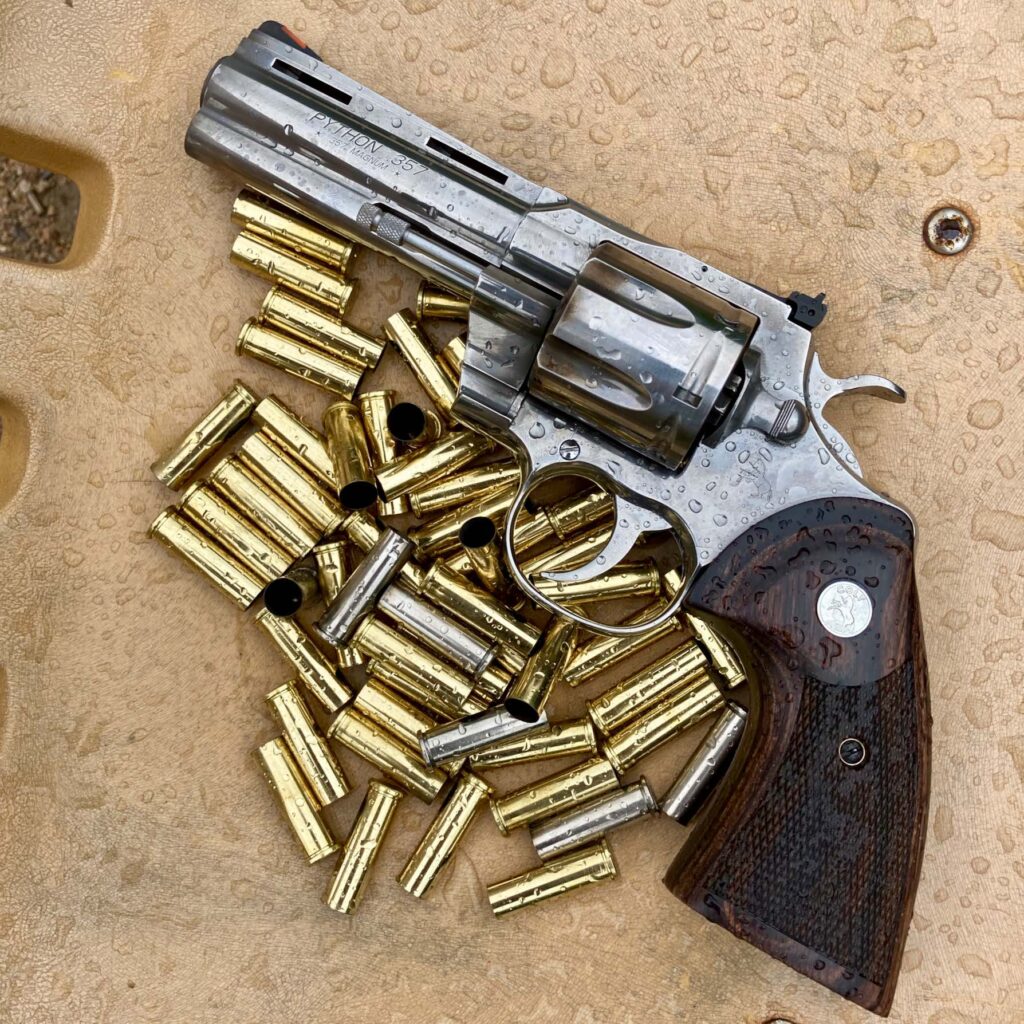
13 May
99 Remington .357 Magnum 110-grain HTP JHP
19 Perfecta .357 Magnum 158-grain JHP
50 Fiocchi .357 Magnum 142-grain TC-FMJ
30 Geco .38 Special 130-grain FMJ
19 May 2020
12 Geco .38 Special 130-grain FMJ
6 Speer .357 Magnum Gold Dot 125-grain JHP
6 Federal Classic .357 Magnum 125-grain JHP
6 Remington .357 Magnum Golden Saber 125-grain JHP
12 Sig .38 Special +P V-Crown JHP
8 Hornady .38 Special Critical Defense 110-grain Flex-Tip
20 Federal .38 Special +P HST JHP
27 May 2020
12 Geco .38 Special 130-grain FMJ
12 Speer .357 Magnum Gold Dot 125-grain JHP
6 Federal .38 Special 148-grain wadcutter
18 Remington .357 Magnum 110-grain HTP JHP
6 Remington .357 Magnum 158-grain HTP JHP
50 Fiocchi .357 Magnum 142-grain TC-FMJ
02 June 2020
18 Remington .357 Magnum 110-grain HTP JHP
6 Federal .38 Special +P JHP
3 Perfecta .357 Magnum 158-grain JHP
59 Winchester .38 Special 130-grain FMJ
50 Fiocchi .357 Magnum 142-grain TC-FMJ

The performance of the Colt King Cobra was admirable. She fired every round with aplomb. I know that still doesn’t address the elephant in the room, though. Some early models of the 2020 Colt Python had some reliability problems which became very, very prolific in the hands of a few writers and YouTubers.
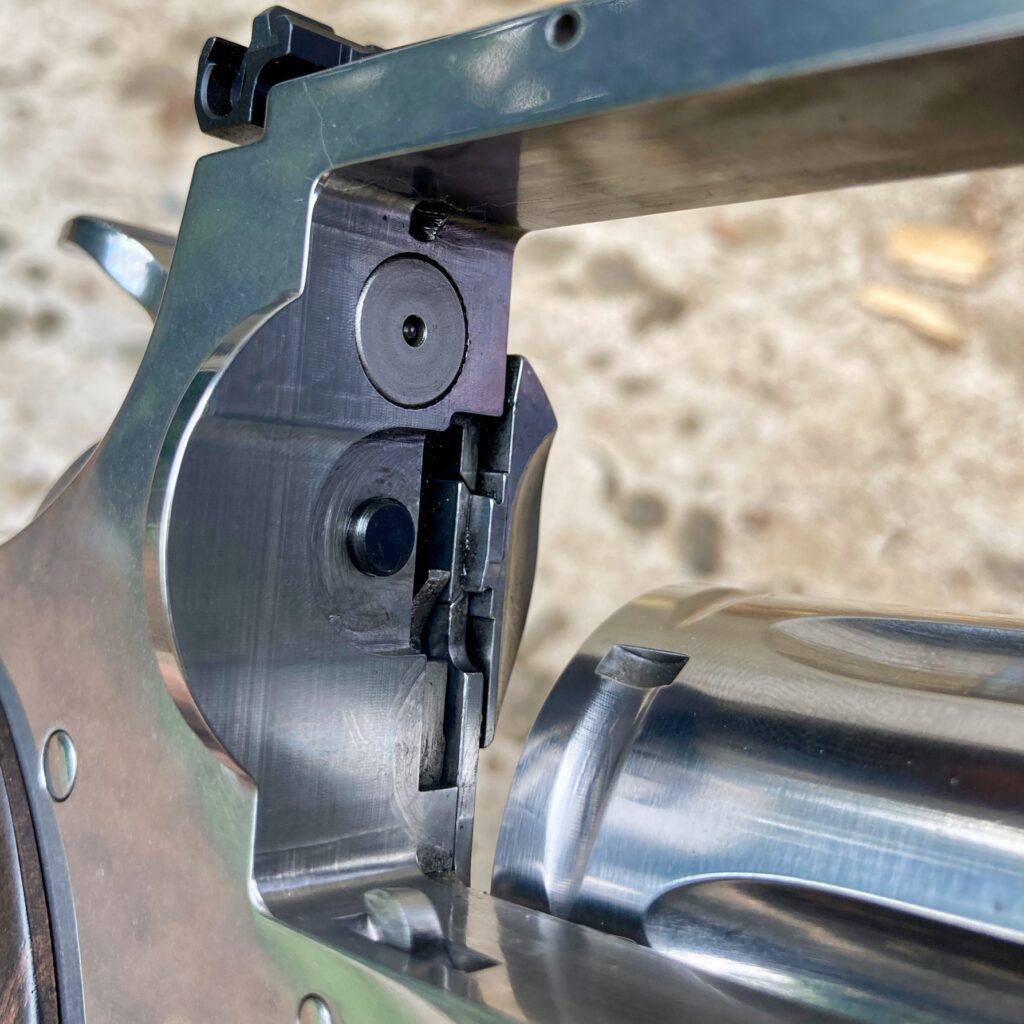
I’ve always thought that a gun must be proven to work. For example, one credible complaint of pervasive reliability issues should be thoroughly disproven before commending a gun as reliable. My belief is that just because my exemplar works isn’t a justification for discounting those whose guns didn’t work. My exemplar did work and admirably so, but I accept that one sample doesn’t really prove much.

My personal take, however, is that Colt’s has acknowledged the issue, which was a loosening the sideplate. The loosened sideplate allowed the hand to fall out of alignment with the star, resulting in a cylinder that did not turn. Colt’s claims to have added Loctite to the sideplate screw. Upon removing the sideplate screw in the exemplar loaned to me I did observe something in the threads that appears to be thread locker. Simply knowing what the issue is alleviates my concern with this particular issue.
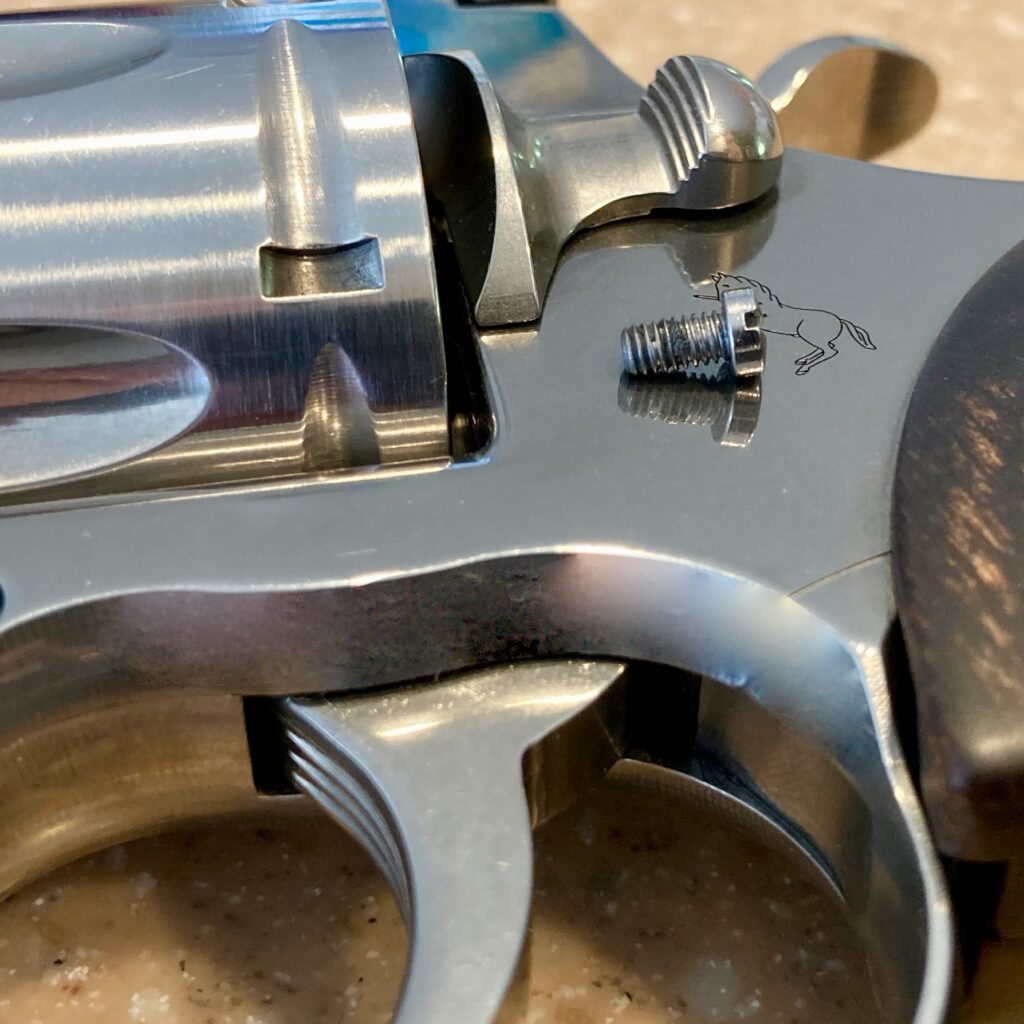
Extraction and Ejection
Opening the cylinder is the same as the old-model Python: pull the latch to the rear. Though I consider myself a S&W man, I am very quickly finding myself adapting to the Colt’s release latch, and to a clockwise rotating cylinder.
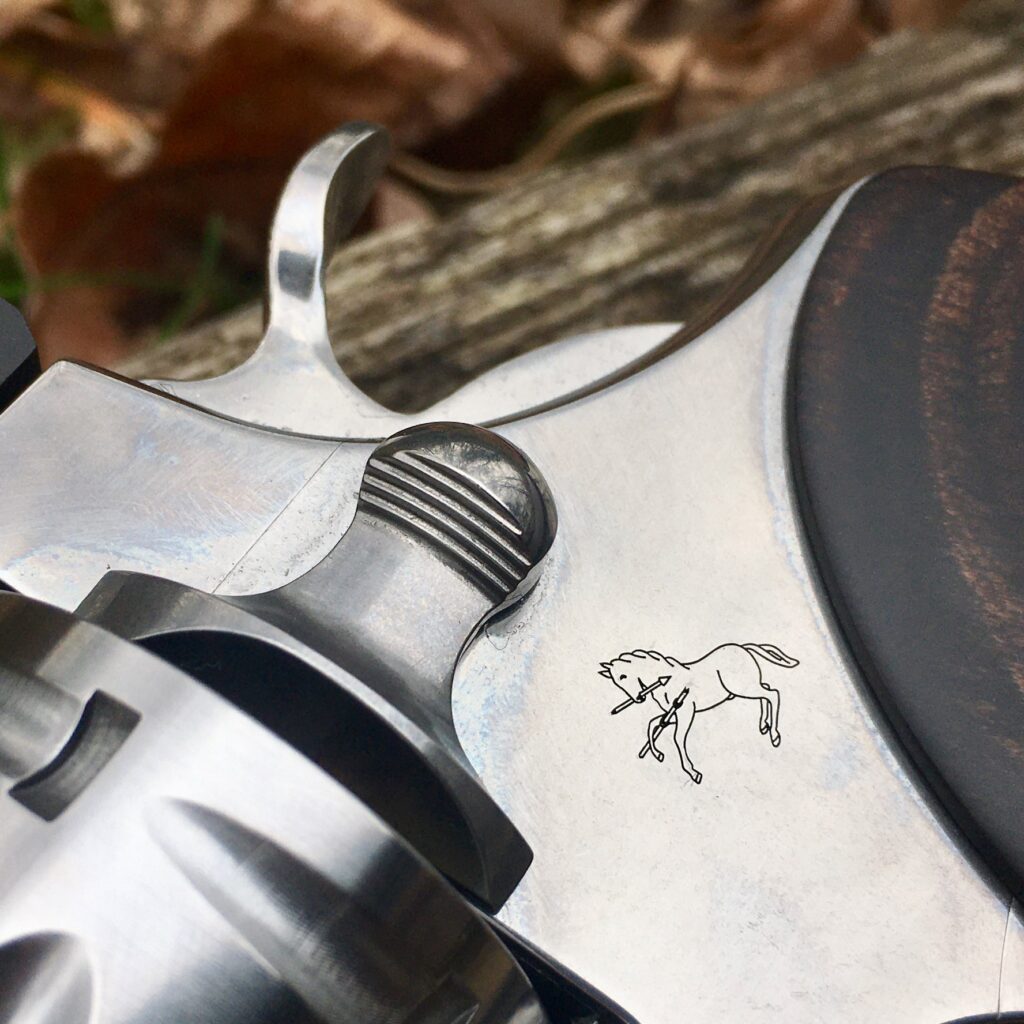
The 2020 Colt Python’s ejector rod is a dream come true. First, the tip of it is nicely rounded, preventing the pain of a sharp, poorly designed ejector rod. Secondly, unlike the early King Cobra’s ejector rod, the tip is much wider than the body of the ejector rod. This prevents potential overtravel of the rod, as well as preventing the ejector rod from becoming stuck in its channel in the crane (something that can happen with the King Cobra).
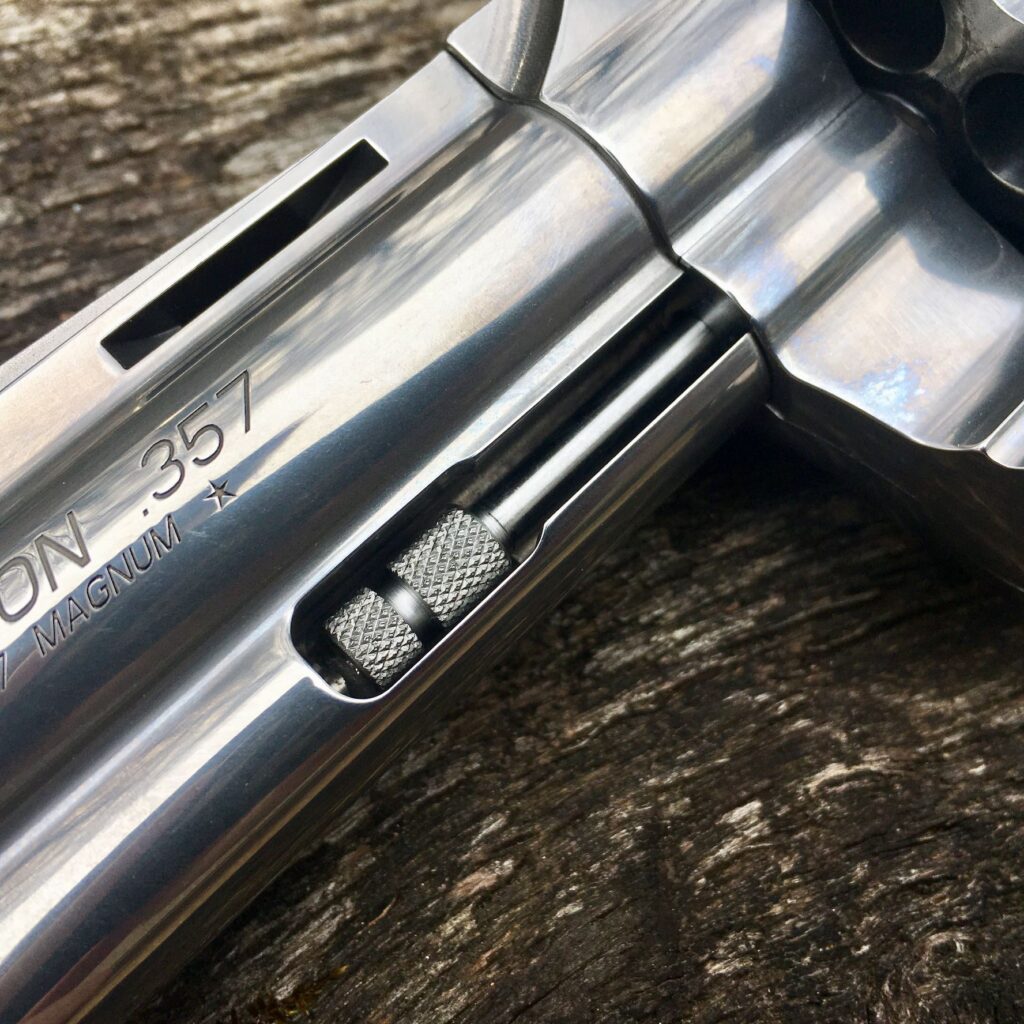
Also note that the ejector rod’s channel in the underlug isn’t just a bland oval. Colt’s machined it to match the contours of the ejector rod itself. This is the kind of little touch that a RevolverGuy can get really excited about!
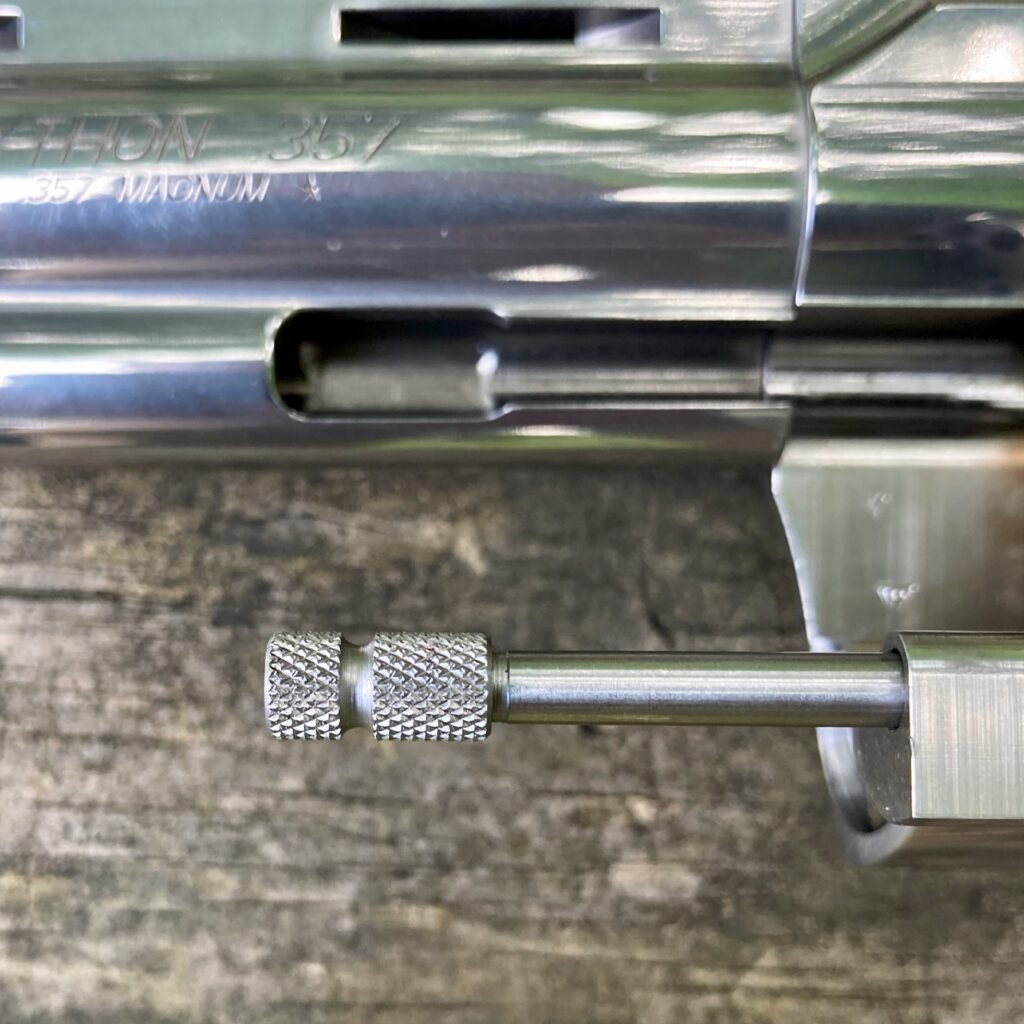
Third, the Python’s ejector rod is a very capable length. I measured the length of throw at 0.885 inches. According to our informal survey of ejector rod throw across popular revolvers, this is right in the middle of the pack and perfectly adequate.
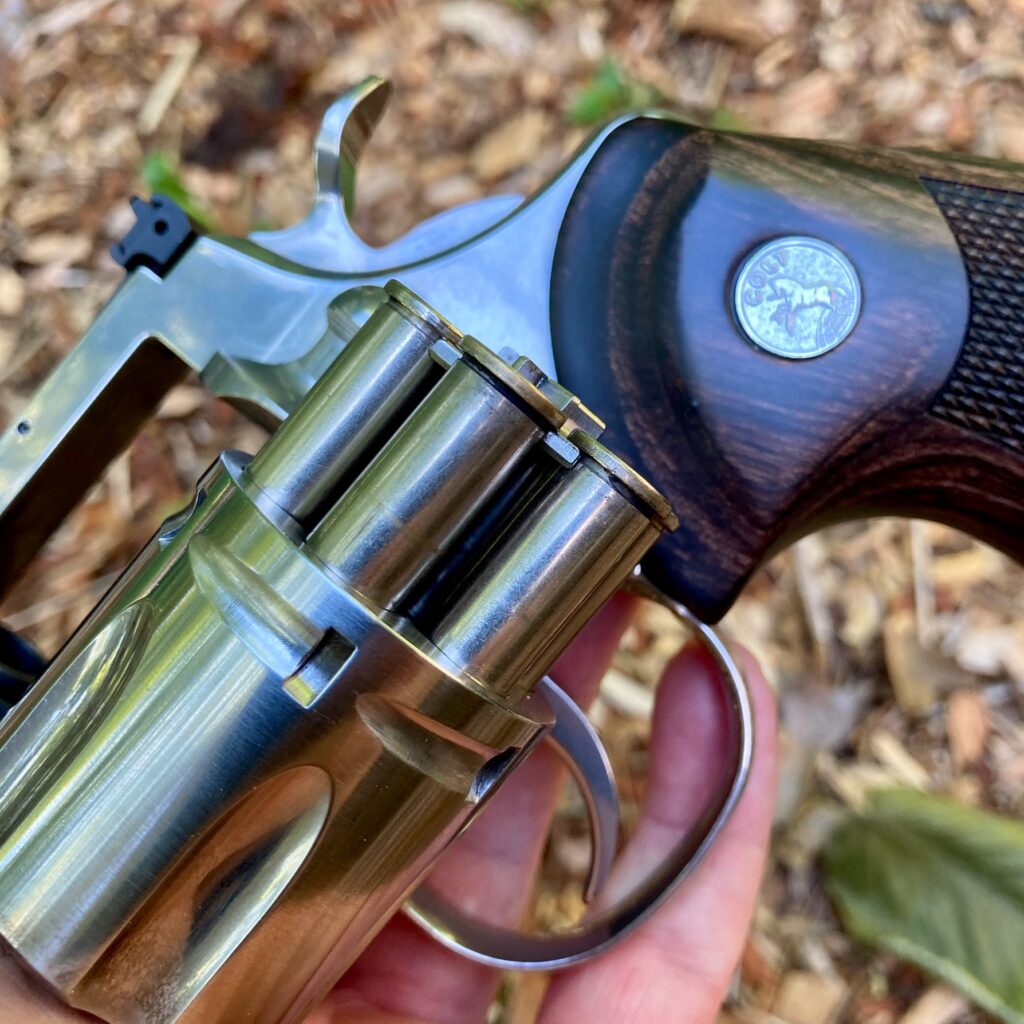
One minor issue did crop up here and there with ejection. There was a tendency of the left grip panel to hang onto a round if I did an “admin” eject. This ever once occurred when I stroked the ejector rod properly: that is, firmly, and with the gun oriented vertically.
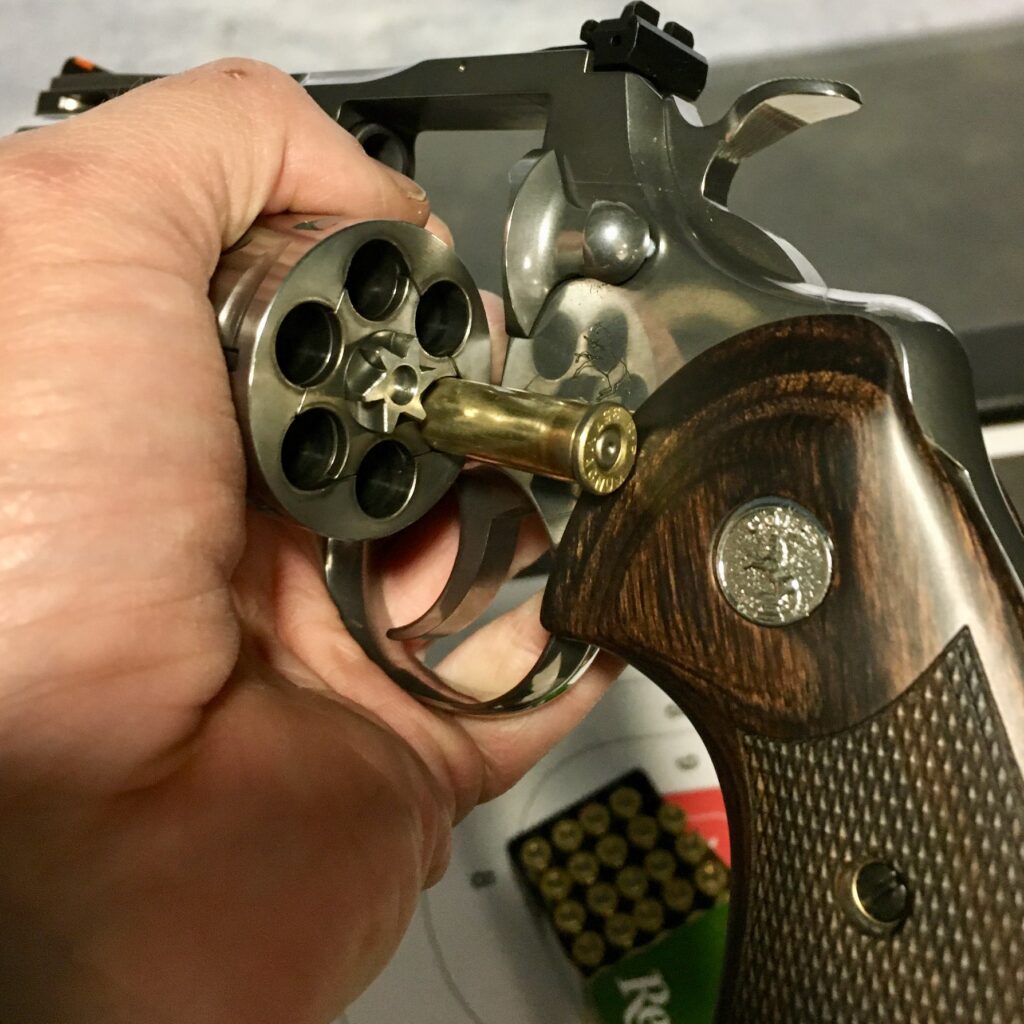
Handling: Not Just a Pretty Face
I did break with our normal revolver testing S.O.P. here. I told you guys I would fire two iterations of Dot Torture – one within the first 100 rounds of testing, and the other within the last 100 rounds – when reviewing any revolver intended or suitable for defensive use. I intended to, but did not fire the first one. Apologies, but I forgot my Dot Torture target on that range day and with the limited range availability I have had I simply couldn’t afford to postpone that session. I did fire a round of Dot Torture as the very last thing I did with the 2020 Colt Python, though. Not only did I fire it, I fired it at five yards, in a steady, soaking rain. Here are my results:
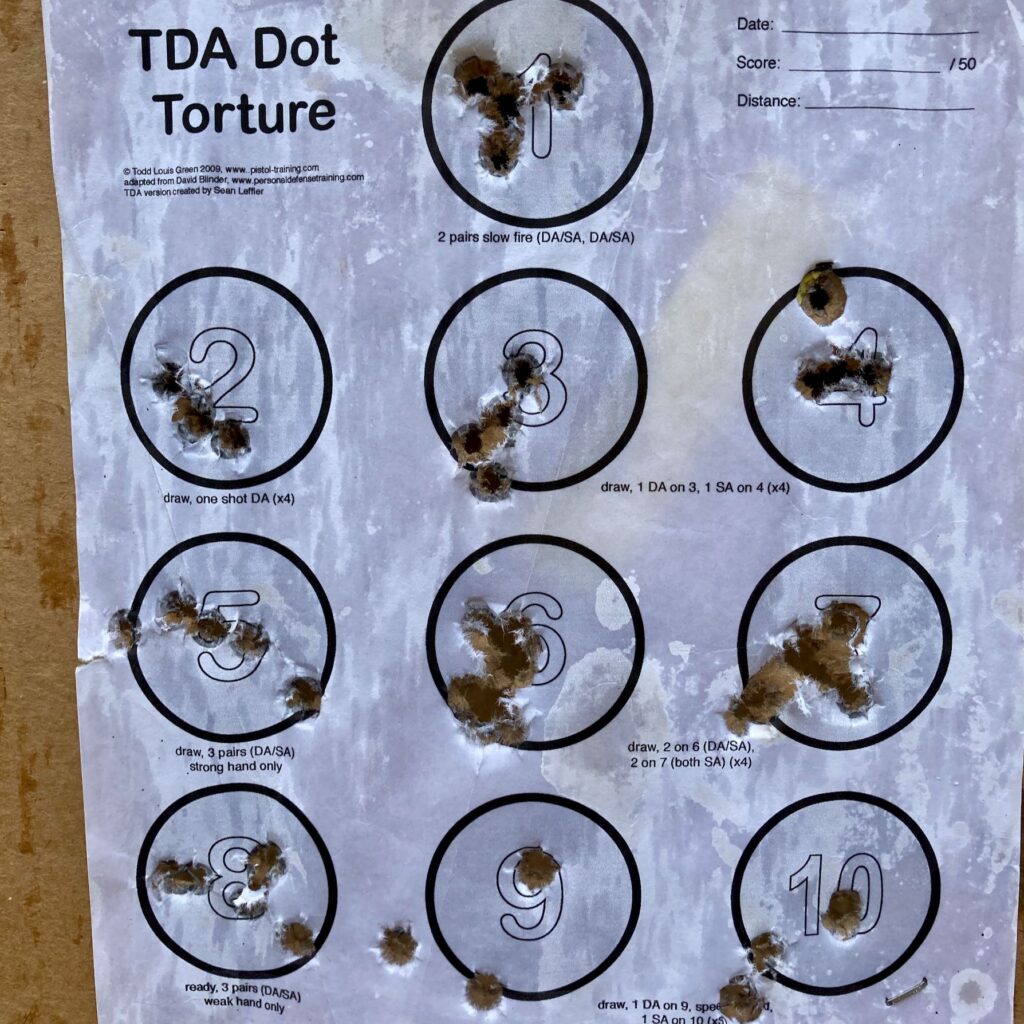
Not bad, considering the weather conditions. Counting broken lines I would score this at a 47. For some reason I dropped two on the last stage, something that is unequivocally my fault. Again, I understand perfectly that Dot Torture isn’t intended to be a test of a firearm, but it does go some distance in demonstrating what a competent shooter is capable of with this gun. Dot Torture was fired from a DeSantis Speed Scabbard using a L-Frame SL Variant speedloader carried in a Jox Loader Pouch.
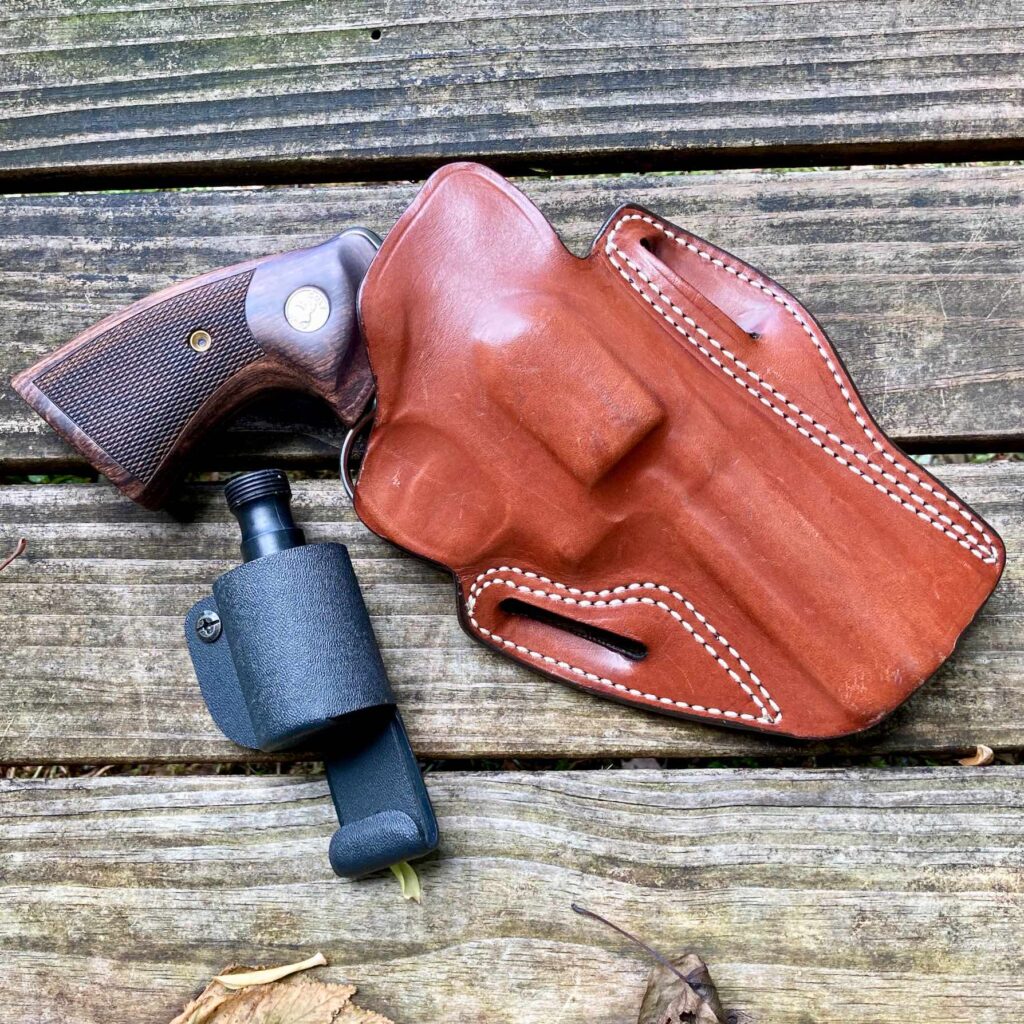
The one minor complaint I have with handling is the grips. While beautiful, I don’t feel that they fill in enough area behind the trigger guard. This leads to my hand rising higher and higher with each shot, until my fingers feel bunched up around the neck of the grip frame. I think this could easily be corrected.
Accuracy
I did some more formal tests for accuracy. For each of several loads I fired a six-round group at 25 yards, offhand, in double action. In many of the groups below you will note the presence of one flier that spoiled an otherwise excellent group. Chalk those up to me because this gun was phenomenally accurate. Let’s take a look at some of the groups below.
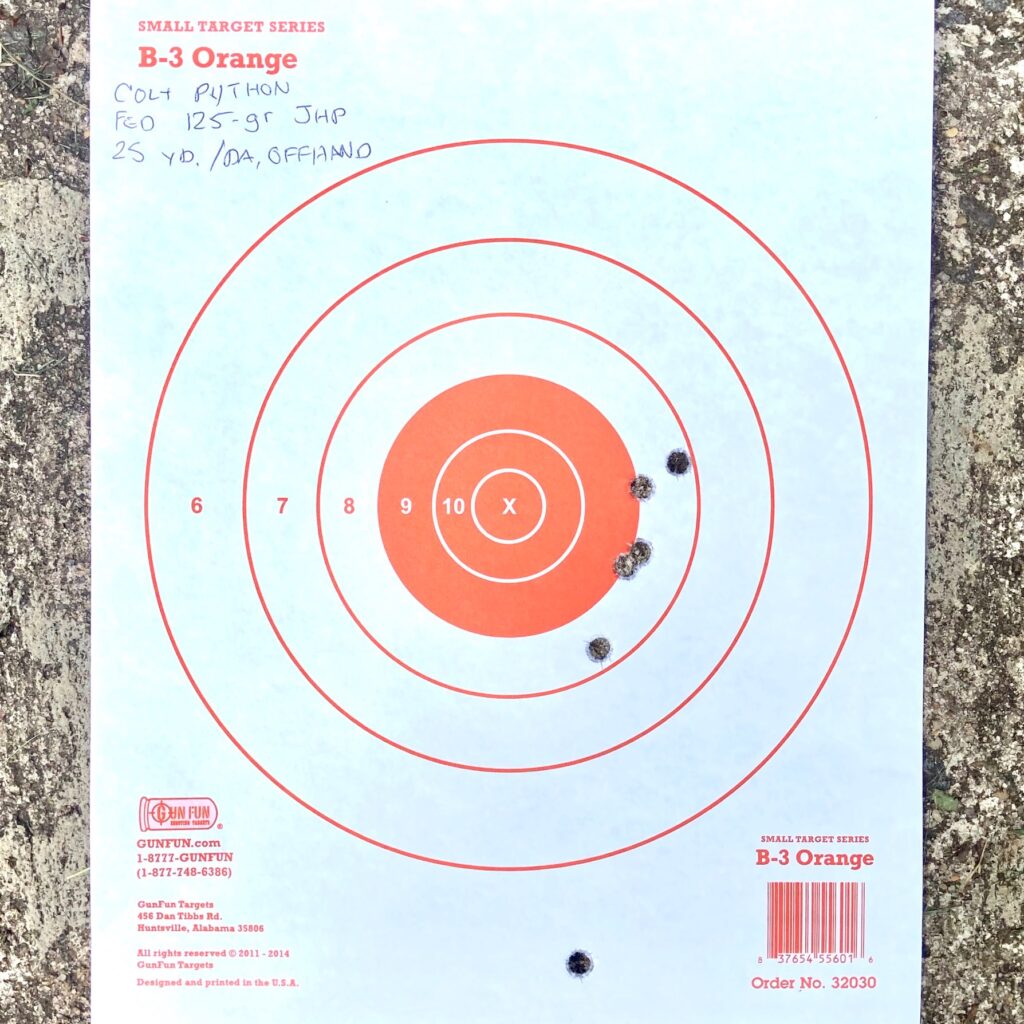
The flier in this group was the second round and was absolutely my fault. I anticipated and pulled it low. That Federal 125-grain JHP loading is the Genuine Article and after the “BANG” and flash of the first one I was jerked the second. Otherwise this is a great group.
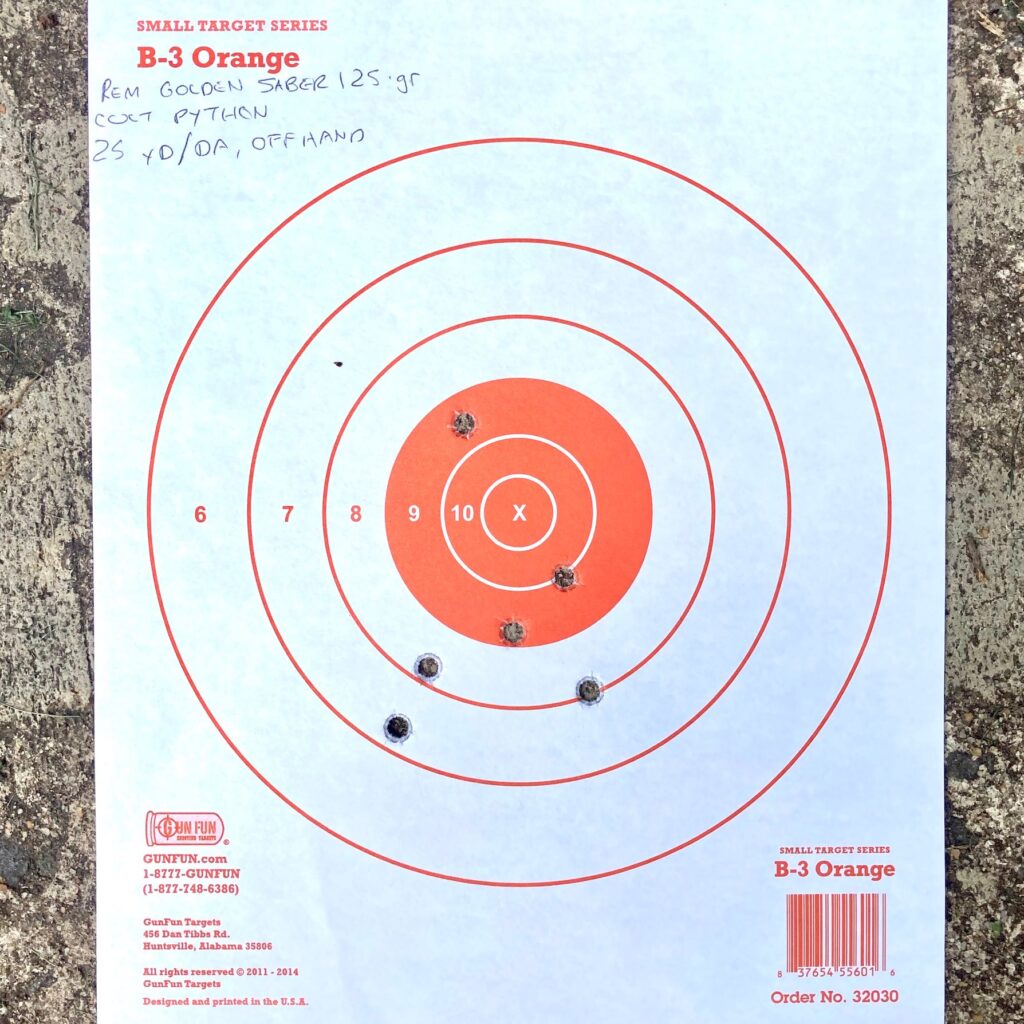
Even with the flier this group with Remington’s 125-grain Golden Saber i .357 Magnum isn’t bad. This is a good loading, having mild(er) recoil, and not insanely expensive.
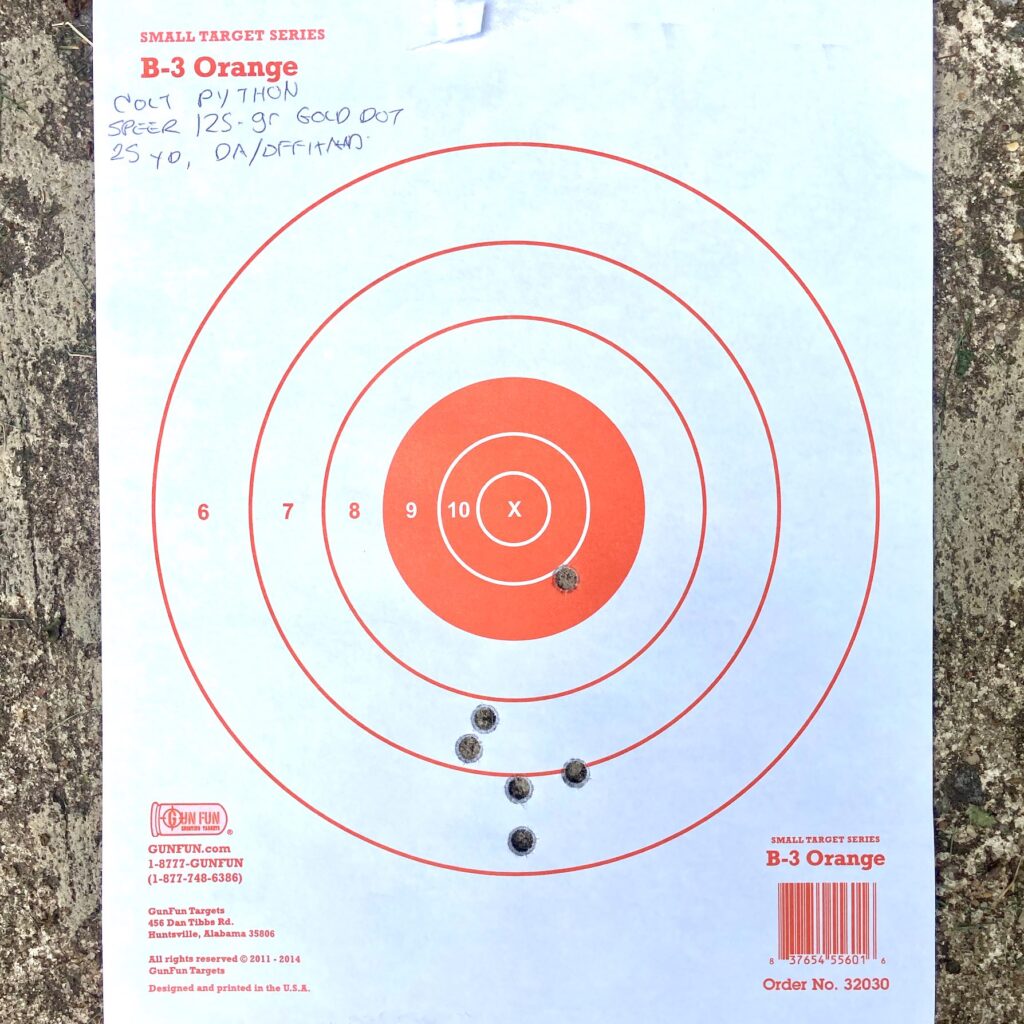
If it weren’t for that one flier… Still, I’m happy with this group from Speer’s 125-grain Gold Dot. I did have a bit more difficulty getting nice, tight groups with .38 Special loadings. I only managed to record a couple: the Sig V-Crown below, and below that a couple groups with the Federal HST.
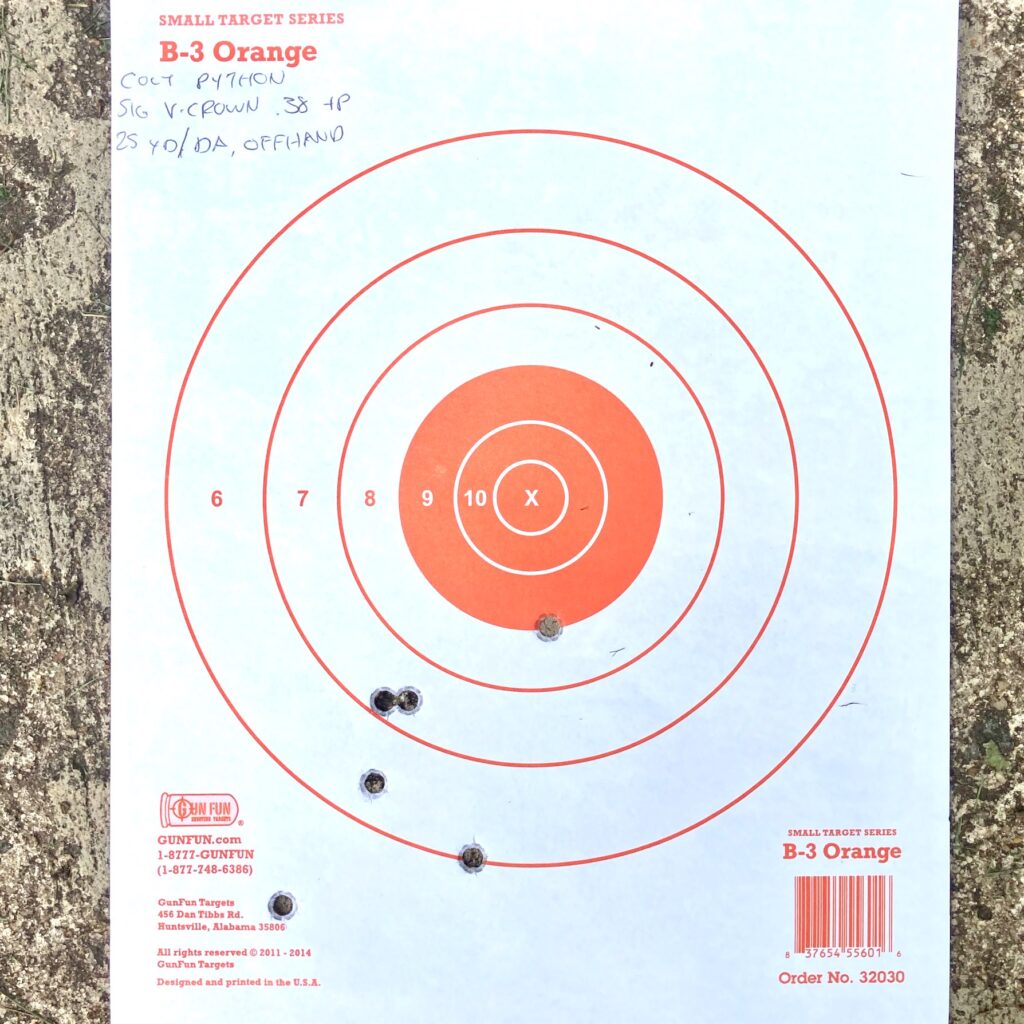
Results with the Federal 130-grain HST were interesting, and this is not the first time I have had difficulty with the Federal loading at extended distance.
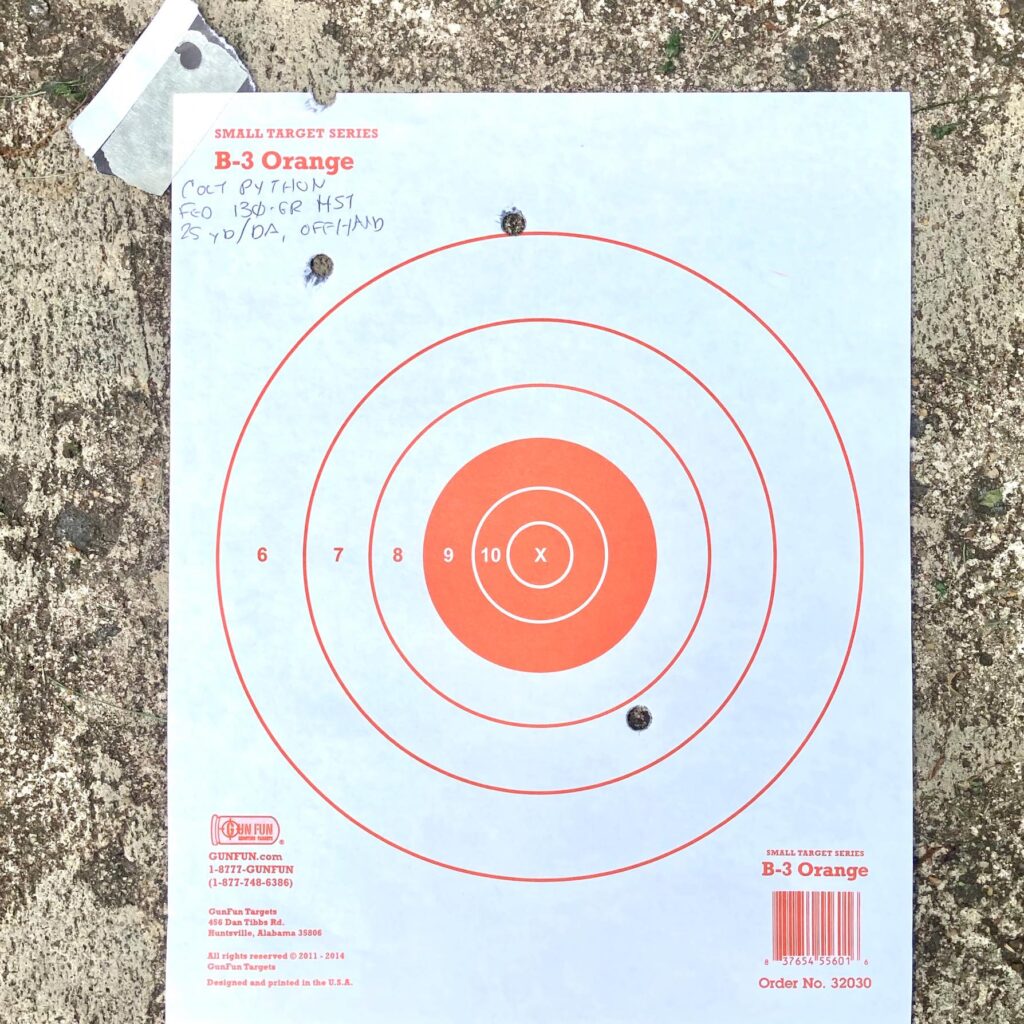
The first group strayed off the page. I did preserver the tape used to hold the target because it does represent one impact with this loading (I added some black paper behind it both to make the hole more visible, and to keep the tape from tearing or sticking to itself on the way home from the range). Not only was I unable to keep it on the paper, it is stringing high and left – almost opposite behavior of the other loads, all of which were tested on the same day with the same sight adjustments. With this dismal group in mind, I decided to shoot one more, with a larger paper backer.

Technically this group is better, but I still only captured five rounds, with no impact/no idea about the sixth one. This is not the first time the premier .38 load from Federal has given really head-scratching results. In my initial review of the King Cobra I recorded some groups with this loading and noted that the published result was definitely a “best of” group. There may be more to follow on this, ammunition permitting, but as of now I would not be comfortable with this load beyond 15 yards.
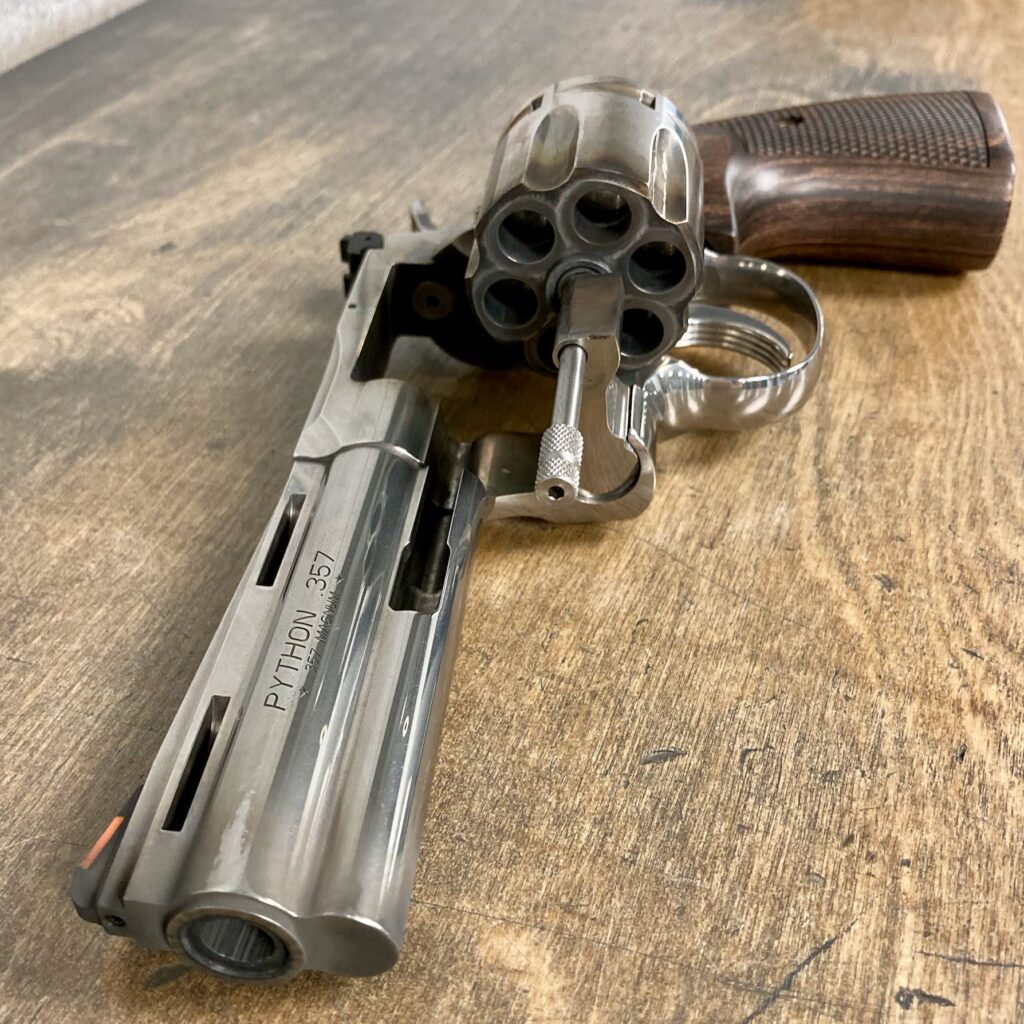
But that’s all slightly off-topic. Back to the subject at hand: the 2020 Colt Python! To put it briefly I am more than impressed with the accuracy of the Python. It is plenty practically accurate and undoubtedly quite a bit more inherently accurate.
Carrying the 2020 Colt Python
Another thing we promise in our revolver testing standard operating procedure is some amount of carry. I did carry the new Python, on and off for about two weeks. The results, honestly, were pretty predictable: carrying the Python is a whole lot like carrying any other full-sized revolver. It’s big and heavy and takes a solid gun belt and a good holster to hold it up.
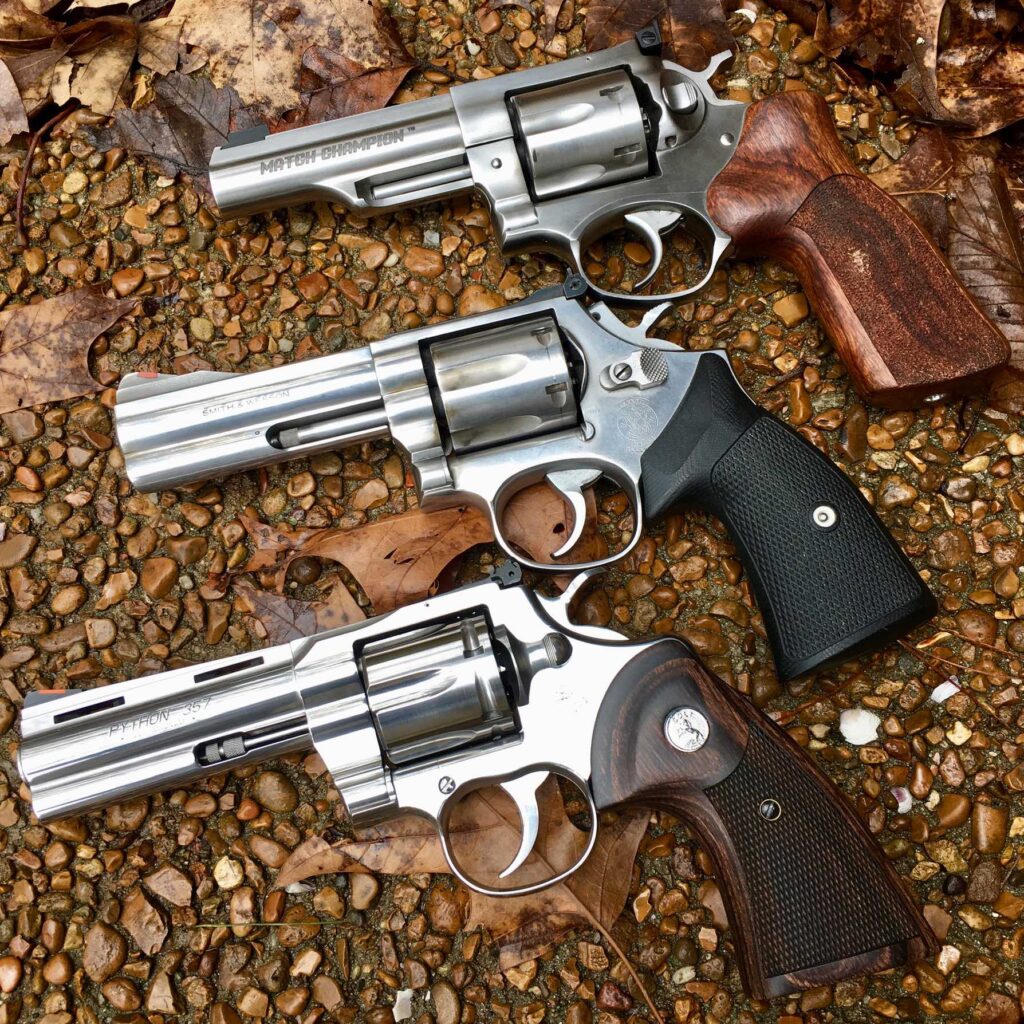
Fortunately – unlike many new revolver models – a plethora of aftermarket accessories exists for the Python. This is because it is compatible with many S&W L-Frame accessories. This makes it really simple to outfit.
The Bottom Line
I have always heard the rumor that, “if they made a Python today like they did then it would cost $5,000 to 6,000.” Now, I don’t know if that’s true or not. The bottom line is I can’t tell you how the 2020 Colt Python stacks up to the old, hand-fitted Pythons. What I can tell you is this is one fine revolver. I think Colt’s has done a tremendous job with this gun. Is it a faithful reproduction? I don’t know, and if you’ve been reading this blog for any length of time you’ll probably know I don’t really care. But the thing works and it shoots phenomenally well. And for that matter it looks really good. I think the 2020 Colt Python is absolutely worth its asking price, and for a guy who doesn’t know better, have a hard time seeing how the old model could be any better than this one.

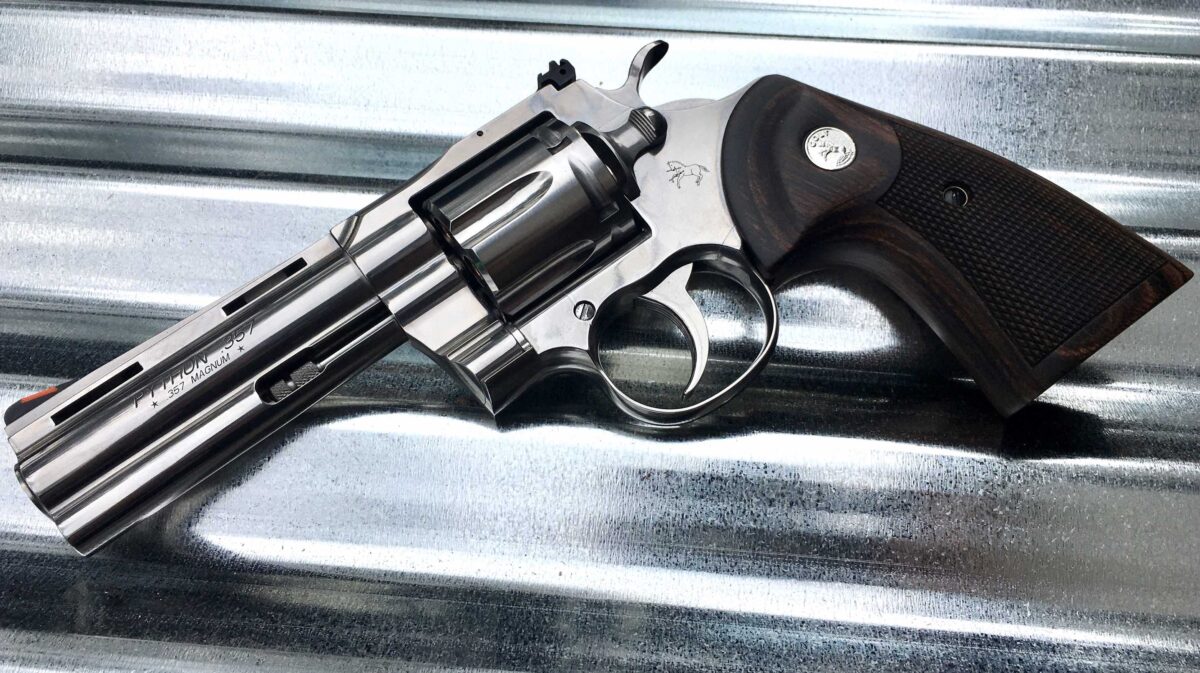
Can’t be sure from the pictures but it
looks like the long cylinder bolt leads
show a fairly prominent turn line.
Original Pythons didn’t have a turn
line as long as timing remained perfect.
The leads were much, much shorter
on the older models.
Thankfully, Colt now uses a basically S&W
cylinder bolt/stop design, having dropped
the old Rube Goldberg design.
Initial testing reports indicated a fairly
slow double action reset on the new
Pythons which still didn’t allow for the
really fast DA drills permitted on the
Smith and Ruger revolvers. I wonder
if on the model tested just how it compares
to any testing against your 686. Did you
still have to allow your trigger finger to come
off the trigger more than on the Smith?
I think even in this case the new Python
must be measured against the Smith in
double action work.
Uncle Ed:
As a matter of practice I try to avoid consuming media about guns I’m reviewing. Reading a lot of articles introduces some bias, and (I believe) it hurts my originality by making me inadvertently more prone to repeat something someone else said. As such I didn’t even know to look for slow DA reset. And unfortunately I dropped the Python off at Fedex yesterday, but here’s what I’ll say:
It was a big enough issue with the Colt King Cobra that I dedicated three paragraphs (and several comments) to it. With the Python it never even crossed my mind because I didn’t notice any untoward behavior in that regard at all. In a word, I felt the trigger reset was fine. Unfortunately, I didn’t test that particular attribute against S&W revolvers, but my gut says it’s about the same.
Further, in regard to a comparison with Smith & Wesson revolvers: this is a hands-down, 100% better action than any new S&Ws I’ve shot (including both 610s and the 648). No question, no doubt, no ifs, ands, or buts – the Python is better by a mile (at least this one). Comparing it to my 686-3 with tens of thousands of rounds on it…now we’re getting closer, and these two would probably give each other some stiff competition. I’ll still take my 686 because it’s what I know, but if I were limited to the new market, I think I might trend toward the Colt revolvers.
I hope that helps. Rambly way of saying, I didn’t see any problem with trigger reset and compared to new S&Ws there’s not even a question.
Many thanks for this thorough review. The gun has a cult, for a reason.
I have planned to buy a new one, as I so enjoy shooting a friend’s 6” blued original. That trigger sold me. Perhaps next year? As I was considering placing my order, however, I scored a second Blackhawk, a 1980 barely fired and in stainless. That is it for buying in 2020.
With my eyes, hitting paper at 25 yards offhand DA is still impressive. I can do that with a Python, and not so much with my other DA guns.
I find it interesting that you comment about the new Python moving in your hand while firing. I have multiple .41 frame DA Colts and they all exhibit the same issue (including a 1977 mfg Python with factory target grips). Elmer Keith commented in “Sixguns” that he preferred S&W’s over Colt’s because he didn’t have to regrip between shots.
Colt has built this same basic grip frame since the 1890’s. I would have thought they would have redesigned it by now.
That being said I will be purchasing a 6” new Python at some point and I carry a 2015 Cobra on occasion ( it doesn’t move in my hand).
Do what I did. Get a pair of Pachmayr Presentation grips for your Python. I got the large Presentations…. I NEVER have to readjust my grip fast firing in DA or SA shooting either. They are so much better than Hogues as to be laughable. Try to find old Pachmayrs, they are much better than the new ones but the new ones work well too.
Brett,
Upon looking closer I see the new Python does
indeed retain the old soft curve backstrap up to the hammer.
In Smiths and Rugers, a rather sharp angle exists
an inch or so below the hammer. Originally the
Ruger DA revolvers mimicked the Colt but soon
introduced the sharp inward curve.
Yes it seems like a trade-off. Square recoil shoulder = more recoil straight back into the web of your hand, but consistent grip from shot to shot without having to re grip. More rounded shoulder is the opposite.
I think Ruger really nailed it with their SP101 and GP100 (rubber) grips. Their trigger reach is pretty short and they have a pronounced recoil shoulder, but there is still a layer of rubber between the metal grip frame and the web of your hand. It helps (somewhat) with magnum loads.
Thank you for this very thorough review Justin. This is a great web site for us wheelgun fans.
Best,
Paul
I’m going to be honest right off the bat and say that I don’t picture myself ever buying this new Python. It’s too expensive for me to afford, I’m not a fan of adjustable sights on my revolvers, I’m not a fan of serrated triggers (feels like my trigger finger tries out sooner dry-firing my old K-Frames compared to a smooth trigger face), and I have no need for the .357 Magnum chambering.
Now with that out of the way, let me say that this is a very good and informative review. Based off what you and others have said, I am pleased that Colt has made an excellent modern version of the Python. I think it’s good that the Python is back, and that people from my generation and younger have the possibility of owning a Python without paying enormously inflated prices for vintage pieces.
This new Python isn’t the revolver for me, but I’m sure there are plenty of people out there who’d relish the chance to finally have one. I hope this Python becomes a success, if for no other reason than having Colt’s continued presence in the modern revolver marketplace is good for competition and variety. If people only ever had S&W, Ruger and Taurus (and I guess Charter Arms) to choose from, that’d just be boring.
Thank you for putting together a very informative article on the Colt Python. There was a time back when it was absolutely necessary to hand fit parts to get exacting measurements and perfect fitting. Thanks to modern day CNC machines that use statistical process control the Python can be produced economically without a large amount of labor cost. Additionally the new Colt Python has been redesigned to enable it to feed on a steady diet of 357 Magnum ammunition. We now get the opportunity to purchase a better revolver than the classic Python. I know that’s not what everyone wants to hear, but as consumers we win. This is an exceptional firearm that will make a great addition to any collection that can be passed on to your children’s children. Truth be told there are a great number of great offerings from Ruger, S&W, and now from Colt that it is easy to pick a winner, especially if it gets a positive review from the Revolverguy
Thank you for putting into words what I was unable to: this probably is a better revolver from a mechanical/function standpoint. There are some minor external differences but if I had the ability to choose between a new-old Python and the new Python, I would choose the new one.
Also appreciate the vote of confidence!
Over the decades, I’ve have four Pythons (the originals). The frame strength was second to none – even more robust than the S&W. But it’s weakness was not in the frame, or crane, or cylinder, but in its lock work.
The internal lock work on the ‘I’ and ‘E’ frame Colts was an abomination of a design, rather delicate and had to be precisely fitted to work. When it worked, the old Python was smooth as silk. The trigger pull stacked miserably in double action. The single action, however, was slick as glass. All four of mine had timing issues, mainly because I shot them a lot — I was under the impression that you’re supposed to be able to do that. Colt’s Mark III and Mark V actions were the best they ever made for strength and durability.
The ‘new’ Python has some lock work redesign, however, unlike the new Cobras, the Python still has holdovers from the old ‘I’ and ‘E’ frame guns. The Cobra’s redesigned lock work should be able to go toe to toe with Ruger or S&W.
I’ve long since moved on from the Python . . .
Agree, the old Pythons needed the hand replaced at regular intervals or they would start to go out of time. Grant Cunningham had an article (can’t find it now) where he said they weren’t delicate and then basically went into detail about how delicate they were.
Also spare parts for the old ones are getting hard to find and very few gunsmiths really know how to fix them.
I’m blessed to have a modest mix of nice Colts and S&Ws.
Invariably if I bring some of both out with new shooters the last two on the table are my Python and Trooper- both on the same I-frame. They’re just special. I’ve never found an E or I frame that was miserable or stacked.
I’m really pleased your experience with the updated version mirrors what many over on the Colt forum are experiencing as well.
Great review as always.
Thanks so much for this review! It’s the most objective review I’ve seen on this new Python and it contains exactly what I wanted to know. That 10 pound smooth DA trigger is especially intriguing.
I’m a lifelong revolver shooter, and always wanted a Python, but never could justify buying one, knowing I would shoot the heck out of it. I’ve heard my whole life about Pythons going out of time with a lot of shooting, and I was always concerned about shooting a $3,000 revolver to the point that it needs the services of an experienced gunsmith that might not even exist at that time.
In the not-too-distant future, I’m going to attain a lifelong goal (putting the last of my kids through college), and I’ve been planning on getting a firearm to commemorate the event and the sacrifices made along the way. I was hoping this new Python would be worthy, and it sure seems like it is. I’ll keep an eye on this model between now and then, but if the reports keep coming up positive (now that Colt hopefully fixed the issues that were initially raised), then I do believe I’ll become a proud Python owner.
Is it a decent revolver? Probably
Is it worth $1500? Probably not
Does it have MIM parts? Yes
Does it have laminated grips? Yes
Does it compare to an original python? No
I just can’t see paying 1500 for this. A top notch condition classic L-frame can be had for much less and is superior in every way. Or one could track down a real python for 3k.
That’s the beauty of a free market and independent thinking, Zeb. It’s not interesting to you and you don’t think it’s a good deal, but there’s a lot of RevolverGuys who would beg to differ. That’s what makes the world go ‘round, and it’s what keeps our industry so diverse. We’re all entitled to our own opinions, likes, and dislikes.
By the looks of what I’m seeing, Colt isn’t having any problems finding people who disagree with you. In fact, I haven’t met a single person who has actually fired the gun that wasn’t impressed with it. I watched several thousand gun writers shoot the gun at SHOT Media Day, and they all walked away grinning like kids at Christmas . . . nobody complained that it wasn’t an original!
Is it a decent revolver? Yes
Is it worth $1500? Absolutely.
Does it have MIM parts? Yes
Does it have laminated grips? Yes
Does it compare to an original python? No, it’s far superior.
There you are, I fixed it for you, you’re welcome 🙂
Double action accuracy testing? I don’t care how much of a shootist you are. I want to know what the gun is capable of. Single action and with a rest, machine rest is even better. Throwing different ammo in the mix doesn’t help much.
I came to this review after searching for S&W Classic DX, which linked to your excellent review of your friends revolver. I have a 629 Classic DX, 6.5”, myself. The test target that accompanied my gun is a true proof of the guns potential-if I do my part.
Colt vs. S&W? I sold my Anaconda at a loss, to get rid of it. Even after factory service for coming out of time and locking up, it quickly started showing timing issues again. I had the good fortune to find the 629 soon after. It has worked flawlessly for many years and never needed any service. It is both a target puncher and a weapon worthy of concealed carry.
That’s just how we do it here, John. There’s plenty of other places where you can find Ransom Rest results if you’re not seeing what you want to, here. We think it’s more useful to get a feel for the practical accuracy of the gun, rather than the mechanical accuracy.
Concealed Carry with a 6.5” S&W 629 DX? Yeah, I don’t see that working for most of us. Congrats to you, if you can pull it off!
I’m glad you enjoyed the other coverage. Thanks for stopping by.
Sorry for the necropost. I have a question about speed loaders and the Python. We’re you able to test Jet Loaders with it? I’ve read conflicting reports regarding L frame speed loader compatibility with the Python. Thank you and Happy New Year!
I’ll be working with a 2020 Python in the coming weeks, and will check on that.
After 18 years of searching, I finally got my python. I bought my 2020 Python from a sporting goods store that sold it right at msrp. Not even marking it up at the height of the gun panic of the past 1.5 years. My range tests are that the gun is super accurate, but the grips are mediocre of all trades, master of none.i. In addition to the plinking at the range breaking it in (and gathering the admiring eye) I shot it through my departments off duty carry course. An easy course made harder by light rain, and sweat from the 90 degree august day. I found the gun would squirm in wet hands. The recoil squirted the grips down through the hand. Something less tapered would be nice. I looked up herretts but they are out of business. I managed to hold together to get through the course and am the single officer on my 700+ department authorized to carry a Colt Python off duty using my badge as my ccw. It’s the gun I go to court carrying. Looks better with a suit I think.
Tony, I was just talking to a custom grip maker about the new Python. He says the old stocks won’t fit the new gun very well, which contradicts the story told by a RevolverGuy friend who says he did just that. This will require further investigation on my part, when I get my gun back from the gunsmith (who is fixing a few minor things for me that bothered me about the new gun).
I agree on the new stocks. They’re attractive enough, but too thin for my tastes and too smooth.
BTW, I’m sure you look sharp in that suit!
The excessive SA trigger pull bothers me – did he fix that for you? If so, who’s your ‘smith?
I purchased a 3″ Python about three weeks ago. I’ve had the Python itch come and go since the Seventies (when I was a child) and finally decided that at 55 years of age it was time to scratch it. I raided my savings account, sold a few handguns and I brought home the 3″ version (the 3″ barrel is a grail gun for me). I like it. It is the most money I have ever paid for a handgun and I believe the $1,446 dollars was well worth it. Well, there is that rear sight, but I have ordered the Wilson sight, and I will be replacing it. It’s a very nice revolver and I finally own a Python.
Congrats Jeff! I look forward to hearing your thoughts on the new Wilson sight.
I will do that Mike. Incidentally I like the Altamont grips that came with it, but I put them on my Colt “357” and put an older pair of Pachmayer Grippers on the Python. There’s esthetics and there is practicality.
Indeed! They’re not very practical.
I realize that I am in a very small, nearly extinct minority of shooters who participate in NRA Bullseye but this revolver was made for events like this yet no Ransom Rest groups are being fired (or perhaps at least not being published) at fifty yards which is the standard for evaluating pistols intended for this discipline. I’m just venting that the true mission of Colt, today as well as in 1955, was not just to produce the finest revolver, but also the most accurate revolver, has taken a back seat to providing a pretty gun that need only “shoot better than me” to be embraced by the market.
Edward, If you have a spare Ransom Rest with Python inserts to send me, I’ll gladly shoot some groups with it to satisfy your curiosity. 😁
Your point is well taken though. These guns are capable of greater mechanical and practical accuracy than reported. Are you seeing any of them being used by your competitors now, in NRA Bullseye?
The Python continues to make history. My first experience was in the Marine Corps when a buddy bought his 4″ nickel Python and I bought a S&W Model 19 4″ in blue. I didn’t care for the nickel finish (at the time) but was amazed as how well it shot. Though I didn’t have the money at the time, I was wishing I had bought a blued Python. That was in the 1970s. By the mid-80’s I was a seasoned firearms instructor and captain of a major federal agency pistol team. I landed an awesome customized 6″ Python in blue that was built by the last of Colt’s true D-Frame gunsmiths. That served as my Distinguished Match revolver and it brought me the NRA Distinguished Expert Badge, the President’s 100, and several match wins. Then I came across a 4″ blued Python that became my Service Match gun, also bringing home some trophies. But for the Off Duty Match, I was still using a S&W Model 19 2 1/2 inch that shot quite well, but is was out of place. The leaf-spring action of the original Pythons provided an amazing trigger, if tuned by someone who had studied the system under a master gunsmith. A steady diet of magnum loads were hard on the timing of those actions. The 2020 Python operates with a very different action. The Colt manufacturing and assembly technicians (can’t call them gunsmiths) have created a very reliable action with an excellent out-of-the-box trigger. The finish, a polished stainless, is excellent . . . but not quite the mirror quality of the old Royal Blue. The 2020 Python is slightly beefier than it’s elder brothers. My chief complaint about the 2020 Python is that damnable serrated trigger face. For a competitive shooter, concentrating on precision, the finger interface with the trigger throughout the firing motion on the fulcrum pivot is very nuanced. While not as important as some other aspects of marksmanship fundamentals, the trigger finger placement and movement through the trigger travel arch can influence lateral motion of the entire pistol when double action trigger releases the hammer. The serrations are unnecessary and when practicing with 300-500 rounds of .38 caliber 158 wadcutter or 158 RNL, the depth of the 2020 Python trigger serrations develop a blister. Recoil with those .30 caliber loads is minimal, it’s the repetitive motion of double action trigger operation that is the problem. Colt or some competent aftermarket firm would do well to offer a smooth face trigger of quality metal and manufacturing with the proper dimensions and finish to retain the great 2020 Python action. Going on 5 years in production, there does not appear to be sufficient market interest to justify the R&D costs. The depth of 2020 Python trigger serrations are so deep they can’t be buffed out without risking damage to or changing the geometry of the trigger. If that’s the only complaint a person can have of the 2020 Python, well I’m quite happy with my 3″ and for some ridiculous I can’t get the idea of “needing” the long lost, now affordable, 2020 2 1/2″ Python.
Sir, thank you for your detailed commentary on the 2020 Python! Like you, I wish the trigger face was smooth instead of grooved. A grooved trigger may have some place on a gun that will be fired in single action, but it’s a horrible choice on a double action.
I also wish Colt would radius the edges of the trigger a little more, to get rid of the uncomfortable corners. Lastly, the gun deserves a much better rear sight, with a deeper notch and repeatable click adjustments.
Having said all that, I’m mighty impressed with what they created!
On a side note, it’s quite an honor to make the President’s 100. That speaks volumes about your shooting skill! I’d love to hear more from you about your thoughts on developing good marksmanship skills and habits.